
How to Ask Gender Questions in Online Surveys (With Examples)

The first questions about a person's sex appeared in the 1790 US Census. In recent years, researchers have increasingly asked questions about gender and sex separately to increase accuracy and promote inclusivity. In fact, in 2020, around 55% of such survey questions included three or more gender answer options, as opposed to the 80% that only offered two options ten years ago ( State of Surveys Report: 2023 ).
Researchers have not yet agreed on the "correct" way to ask gender questions in online surveys. Still, best practices are emerging to help ensure that sex and gender are not conflated and that survey measures accurately reflect the diversity of the population.
Why Gender Questions Matter
Gender is a social construct shaped by society's cultural expectations and norms. It is affected by factors such as religion, language, family dynamics, and more. Unlike sex, which is assigned at birth based on physical characteristics, collecting information about gender more fully encompasses the socio-cultural and psychological experiences important to research projects.
According to Pew Research Center , "Gender affects how a person sees and is seen by the world. It's predictive of things like voting behavior, the wage gap and household responsibilities."
A note about terminology: sexual orientation is often referenced alongside gender questions, abbreviated as SOGI (sexual orientation and gender identity). It is worth noting that sexual orientation is distinct from sex and gender. While you may see SOGI referenced in the context of gender questions below, the focus of this post remains limited to sex and gender questions.
Best Practices for Gender Questions
Gender questions are nuanced and require particular attention to context, verbiage, and placement. To properly conduct gender questions, researchers should follow guidelines such as using precise language, avoiding assumptions, and validating responses, as well as the additional best practices listed below.
Keep Sex and Gender Questions Separate
It is important to remember that sex and gender are separate concepts and require individual questions. Sexual characteristics are determined by the chromosomes and biological characteristics of a person. Thus, these questions are often simple and direct, for example:
What is your sex?
1. Male 2. Female 3. Intersex
Alternately, you may see this question phrased as "What sex were you assigned at birth?" In either case, you acknowledge the binary nature of asking a question about biological sex.
Don't Ask for More Than You Need
Unless it is necessary to reach the survey objectives, questions about gender may be omitted. This is frequently true for B2B research and studies that already include sex in their standard demographic data collection. Other gender-related questions, such as gender presentation (how you outwardly express your gender) or preferred pronouns, are frequently unnecessary and should be avoided unless relevant to your research objectives.
Provide Write-In Options
Write-in options accommodate respondents who do not identify with the pre-defined gender choices. The wording of write-in options is critical to avoid confusion or a sense of judgment. Examples of empowering write-in options include:
- "I use a different term"
- "Prefer to self-describe"
- "A gender not listed here"
Examine Your Question Placement
It is common to group sex and gender questions with other demographic questions, but you may wish to group them with questions specific to your study. For example, in a study about access to health care, the gender questions could be grouped with questions about insurance coverage, while your question about sex is placed alongside questions about race and ethnicity.
Use Inclusive Language
The Federal Committee on Statistical Methodology (FCSM) 's Updates on Terminology of Sexual Orientation and Gender Identity Survey Measures report acknowledges that when respondents do not see themselves represented in the categories offered, they have challenges responding. This lack of representation can result in lower levels of engagement and a reduced likelihood of survey completion.
When creating your list of potential answers, aim to strike a balance between inclusivity and survey usability.
Pew Research also notes that proponents of additional gender response options may perceive the lack of other options as exclusionary. This can be remedied by offering additional options in the choice set that are representative and inclusive of all voices.
There are several common gender categories, including, but not limited to:
- Genderqueer or genderfluid
- Transgender man
- Transgender woman
Consider Opt-Outs
If balancing the survey, sex or gender demographic information will be required upfront. If you are not balancing, however, these questions can be asked at the end of the survey and made optional, or you can provide a "prefer not to share this information" answer choice. The FCSM also cautions that while item nonresponse is relatively low for SOGI questions, even low rates for nonresponse can be problematic when measuring a small population.
4 Examples of Inclusive Language in Gender Survey Questions
The use of inclusive language builds trust with survey participants. Although it is impossible to create a choice set for all gender options, it is feasible to use terminology that can be understood across most English-speaking countries to reflect LGBTQ+ identities.
Example #1: Very Inclusive Gender Question
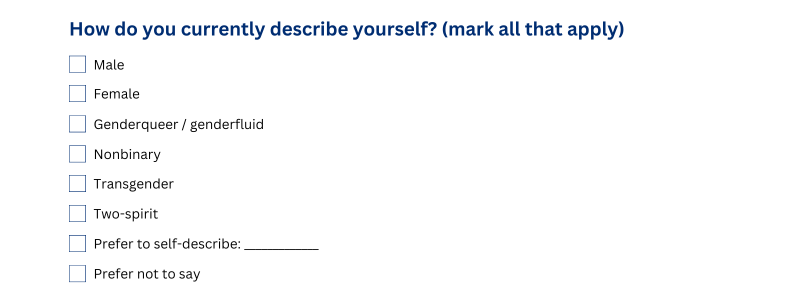
The gender question above uses inclusive language, incorporating multiple gender identities while still keeping the response list manageable. Using a multi-select format allows participants to better align themselves with the answer options, including those with multiple gender identities. The write-in option provides space for identities outside the choice set, and a prefer not to say option allows participants to opt out of the question entirely.
Pew Research Center phrases their question precisely to ensure inclusivity: "Do you describe yourself as a man, a woman, or in some other way?" with a write-in option for the respondent to describe themselves. Pew views this verbiage as more inclusive than the binary responses of "male" and "female" and feels this phrasing more accurately captures data representative and inclusive of all types of voices.
Example #2: Reasonably Inclusive Gender Question

The way this question is framed, responses are limited to a smaller choice set; however, there is a fill-in option to self-describe and an alternative to opt out of the question entirely.
Example #3: Minimally Inclusive Gender Question

While this question does provide options beyond male and female, it offers a limited number of alternatives and fails to capture more nuanced gender demographics.
Example #4: Non-Inclusive Gender Question

Gender options should not be treated as binary or lumped together as "other" without a write-in option. This is dismissive and marginalizing to people who identify as non-binary or have other gender identities. Additionally, some people identify with multiple gender identities, such as female AND transgender or Male AND genderfluid. Without additional options or opportunities for write-in answers, the data collected is unlikely to represent the true characteristics of the population being studied.
Testing and Iteration
When testing your overall standards, pay close attention to any sex or gender questions in your questionnaire.
If you can pilot test with a group of respondents, aim for diversity and ask about clarity, inclusiveness, and sensitivity. Use this feedback to make adjustments before fielding the survey.
Use Cases: Gender Questions in Research
In the world of healthcare, Stanford University’s Gendered-Related Variables in Health Research states that medical evidence has shown that both sex and gender interact to influence health and disease. Analyzing the influence of gender on health requires tools that disaggregate these dimensions and quantify them. “Conflating birth sex and gender identity, however, can lower the precision of survey research.”
The significance of gender in research is not limited to healthcare. Another Stanford case study, the Quality Urban Spaces: Gender Impact Assessment , showed the impact of gender data on city planners. By including gender questions in their surveys, city planners designing family-friendly streets and public spaces were able to understand who benefits from urban design and who is left out.
Other study use cases include:
- Employee engagement
- Employee satisfaction
- Organizational culture
- Labor market studies
- City planning
- Customer surveys
- Consumer market research
Additional Resources
Below are a few resources you can browse if you are interested in learning more about sex and gender questions in online surveys:
- National Academies Science, Engineering, Medicine - Measuring Sex, Gender Identity, and Sexual Orientation for the National Institutes of Health
- Williams Institute - Best Practices for Asking Questions to Identify Transgender and Other Gender Minority Respondents on Population-Based Surveys (GenIUSS)
- American Psychological Association - Inclusive Language Guidelines
- Vanderbilt University - How to Ask About Sexuality/Gender
- United Nations - Toolbox for Using Gender-Inclusive Language in English
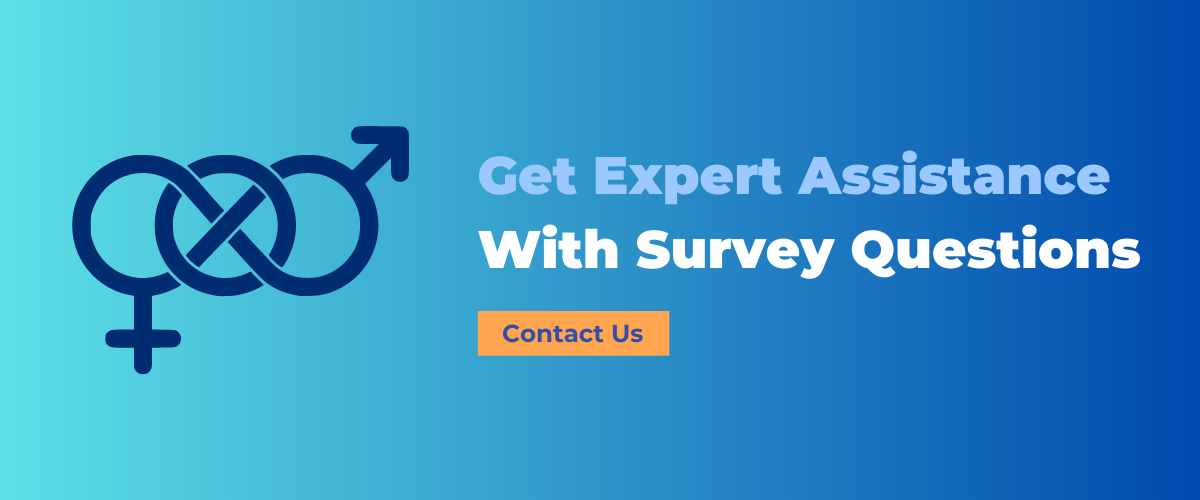
Subscribe to our Monthly Newsletter
Related posts.

Maximizing Survey Participation: Effective Online Recruitment Channels
Maximizing participation in your online survey begins with understanding your target audience. By...

Balancing the Scales: Using Survey Quotas for Representative Research
Survey quotas are vital for gathering representative, accurate research results. Without them, your...

Survey Length Perspectives
Surveys can vary widely in length, from just a few questions (e.g., rate your experience and tell...

How to Write Gender Questions for a Survey
- Survey Tips

Conducting research with an online survey platform like Alchemer gives you easier access to more people, but it requires asking demographic survey questions to understand the data. Sometimes you don’t need this data, other times it contributes a lot to the richness of your findings.
When it comes to demographic survey data, gender and age are two of the most commonly asked questions. These basics are genuinely useful for analysts to slice and dice information.
But the days of giving respondents only “Male” or “Female” as their gender options in surveys have long passed. Even if you’re not asking demographic survey questions for college students.
The challenge for current users of online survey software is to balance the need to collect actionable data with the importance of creating an inclusive range of gender choices. And do it all without risking survey fatigue.
We’re going to take a look at two extremes on this spectrum — basic binary gender options and a survey with 25 gender choices — so we can ultimately identify a gender choice question that provides useful data while being respectful of respondents.
Extreme #1: Too Many Gender Options
In January of 2016, The Sun reported that teenagers in the United Kingdom were given a list of 25 gender options in a Government-backed survey distributed by the Department of Education.
In a rebuttal of the survey and its larger goals, the Associate Editor of The Spectator , Toby Young, provided this full list of the options:
6. Young woman
7. Young man
8. Trans-girl – Someone who has or is currently transitioning from male to female.
9. Trans-boy – Someone who has or is currently transitioning from female to male.
10. Gender fluid – Those who have different gender identities at different times.
11. Agender – Those with no gender identity or a neutral identity.
12. Androgynous – Partly male and female. Not one specific sex.
13. Bi-gender – Those who experience two gender identities, either at the same time or swapping between the two. These can be male and female or other identities.
14. Non-binary – A blanket term to describe those who do not feel exclusively male or female.
15. Demi-boy – Someone whose identity is only partly male, regardless of their birth gender. They may or may not also identify as another gender.
16. Demi-girl – Someone whose identity is only partly female, regardless of their birth gender. They may or may not also identify as another gender.
17. Genderqueer – Those who don’t go along with traditional gender distinctions.
18. Gender nonconforming – Those who do not follow conventional ideas about how they should look or act based on their birth gender.
19. Tri-gender – Shifts between three genders, which could include male, female and genderless or another combination.
20. All genders – Someone who identifies as every possible gender option.
21. In the middle of boy and girl – An individual who identifies somewhere in between male and female.
22. Intersex – Someone with physical, genetic and hormonal features of a male and female.
23. Not sure
24. Rather not say
25. Others (please state)
While the survey has since been withdrawn (a spokesman said it was a draft that hadn’t been cleared by the commissioner), it reveals the perils of over-asking in your survey gender questions.
Inclusivity is vitally important, but survey best practices dictate that we also need to avoid fatiguing the people taking our surveys. Certainly a massive list of answer options like this one falls under the category of “highly fatiguing” questions.
Of course, the other extreme is not any better.
Extreme #2: Male or Female. Period.
If the broader argument for inclusivity doesn’t move you, consider that limiting your gender choices to the traditional binary may also have a negative impact on your survey’s data.
Stanford sociologist Aliya Saperstein reminds us that, “If the world is changing and [surveyors] are not changing the measures, it’s not clear that we’re getting the information we think we’re getting, even if we ask the same questions we always have.”
Sociology professor Laural Westbrook agrees: “We have been taking gender categories for granted for too long. It doesn’t help us better understand health disparities or income gaps or voting patterns to always divide the population into he’s and she’s.”
Clearly, continuing to ask the same questions the same way in perpetuity in the name of longitudinal research is not a useful way to maintain data integrity. Nonetheless, this problem persists throughout the survey, research, and feedback worlds – from government forms to SparkPeople.com surveys.
A.J. Walkley recently reported on the Huffington Post that a poll of fellow activists revealed a stunning lack of options in survey questions: “I was overwhelmed by stories of the lack of inclusion on forms they’ve been given to fill out from various institutions, including LGBT+ groups themselves.”
We can do better, and making your survey questions inclusive doesn’t have to destroy your data either.
Suggestions for More Inclusive Gender Survey Questions
There are really two parts to creating a positive experience around asking respondents to provide gender survey data:
- Determine why you’re asking about gender in the first place. If it’s not a crucial part of your data analysis plan, you may be able to eliminate the question altogether.
- I f you do decide to ask about gender, craft the question carefully. Be sure you don’t conflate biological sex and gender, and create a question that allows respondents to answer honestly and comfortably. We’ll give you some examples to help you get started.
When to Ask About Gender in Surveys
The Center for Diversity & Inclusion at American University suggests spending some time in introspection before asking about gender in a survey. The Human Rights Campaign echoes this sentiment, particularly when it comes to employers collecting demographic data about employees with employee satisfaction surveys and employee engagement surveys.
Consider these questions:
- Why is the survey collecting information around gender, sex, and/or sexual orientation?
- How will the information be used?
- Will the data be broken down by category or used for cross-tabulation?
- What is the business rationale for asking about gender on this particular form?
- How will the data be used, protected, or reported? What legal restrictions might there be on the collection or storage of demographic data, in the U.S. or globally?
American University reminds survey creators that, “Often the questions are asked because we feel like they should be asked, or because we consider them ‘standard’ demographic questions, not because the data are necessary for cross-tabulation.”
If you decide gender will be an important data point for your survey, make sure you follow these guidelines when designing the question.
Best Practices for Collecting Gender Data in Surveys
First and foremost, make sure you keep questions about sex, gender, and sexual orientation separate. This doesn’t mean that you need to collect data about all three, only that you make sure your questions address the category you’re actually interesting in.
These distinctions from American University’s Center for Diversity & Inclusion offer a useful guide:
Sex refers to the biological make up in terms of chromosomes, hormones, and primary and secondary sex characteristics. When asking about sex as a category, words like male, female and intersex should be used.
Gender identity refers to the internal/psychological sense of self, regardless of what sex a person was assigned at birth. When asking about gender as a category, words like woman, man, and trans* should be used.
Sexual orientation refers to a person’s emotional, physical, and sexual attraction to other people. When asking about sexual orientation as a category, words like gay/lesbian, bisexual/pansexual, and heterosexual should be used. Please note that homosexual is not recommended as it is often used in a pejorative tone.
Sample Gender Questions
These are some of the best options for collecting gender-related data. When choosing the one that’s right for you, keep your data analysis goals and respondents’ situations in mind. Remember, you want to balance your own need for information with the personal feelings of the people taking your survey.
Completely Open Ended Question:
Gender? ___________
You’ll have to do some open text analysis on these responses, but it makes it very easy for people to choose their own category.
Options for Cross Tabulation
If you know you need this data in set categories to aid in data analysis, you can still create respectful categories without overwhelming respondents.
We suggest a radio button question like this (although what works for your particular audience may differ slightly):
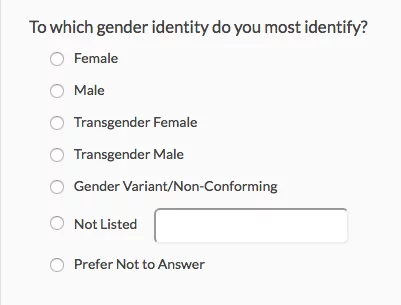
Note that the best way to phrase this question is something like, “To which gender identity do you most identify?” rather than simply, “Gender.”
The Importance of Gender Questions in Surveys
In their 2015 study, “New Categories Are Not Enough: Rethinking the Measurement of Sex and Gender in Social Surveys,” Saperstein and Westbrook drive home the importance of thinking critically about the way we ask about gender in our surveys:
“A hyper-gendered world of ‘males’ and ‘females,’ ‘brothers’ and ‘sisters,’ and ‘husbands’ and ‘wives’ shapes what we can see in survey data. If not altered, surveys will continue to reproduce statistical representations that erase important dimensions of variation and likely limit understanding of the processes that perpetuate social inequality.”
So please, choose your survey questions (and response options) wisely.
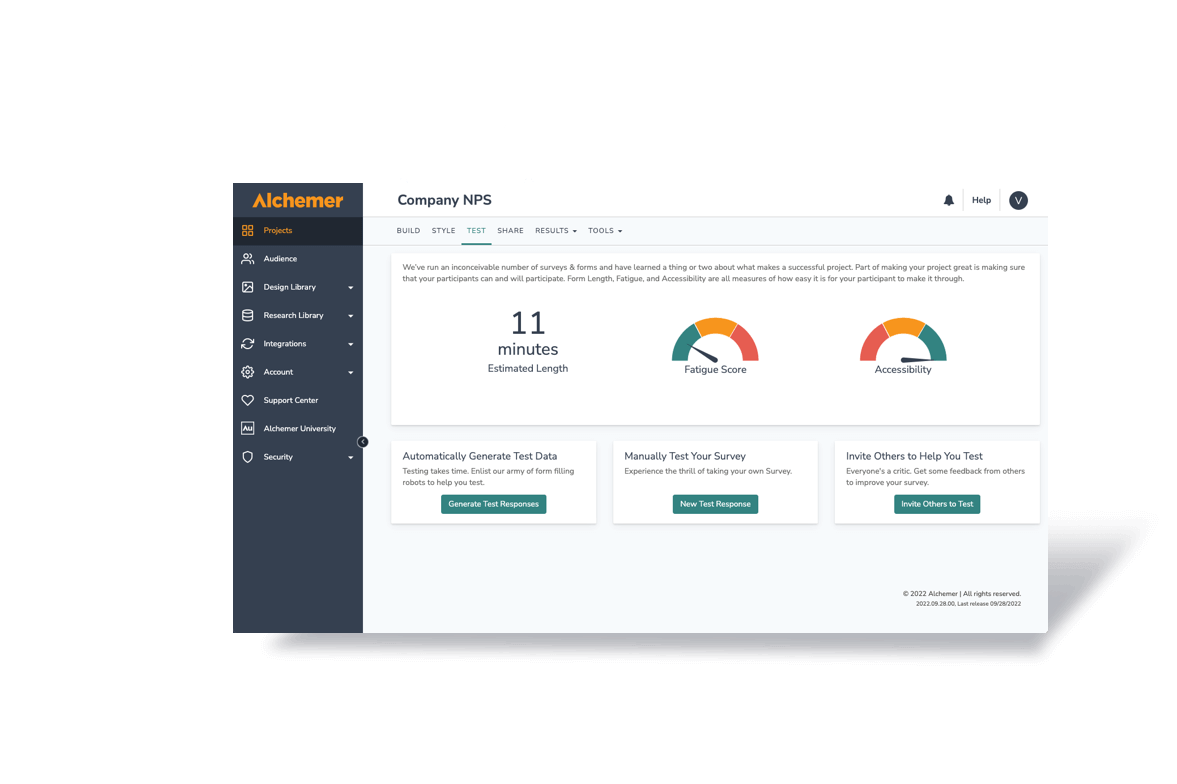
See all blog posts >

- Alchemer Survey , Survey Tips

- Company News , Press Release

- Customer Experience , Customer Feedback , Sentiment analysis , Text analytics
See it in Action
- Privacy Overview
- Strictly Necessary Cookies
- 3rd Party Cookies
This website uses cookies so that we can provide you with the best user experience possible. Cookie information is stored in your browser and performs functions such as recognising you when you return to our website and helping our team to understand which sections of the website you find most interesting and useful.
Strictly Necessary Cookie should be enabled at all times so that we can save your preferences for cookie settings.
If you disable this cookie, we will not be able to save your preferences. This means that every time you visit this website you will need to enable or disable cookies again.
This website uses Google Analytics to collect anonymous information such as the number of visitors to the site, and the most popular pages.
Keeping this cookie enabled helps us to improve our website.
Please enable Strictly Necessary Cookies first so that we can save your preferences!
A behind-the-scenes blog about research methods at Pew Research Center. For our latest findings, visit pewresearch.org .
- Demographic Research
Adapting how we ask about the gender of our survey respondents

Knowing the gender of our survey respondents is critical to a variety of analyses we do at Pew Research Center. Gender affects how a person sees and is seen by the world. It’s predictive of things like voting behavior , the wage gap and household responsibilities .
On nearly all surveys we conduct in the United States, we ask people, “Are you male or female?” (Or, in Spanish: ¿Es usted hombre o mujer? ) While this wording has been the standard question we’ve used for years, we wondered if we could find a new way to ask about gender that would acknowledge changing norms around gender identity and improve data quality and accuracy, while still maintaining the neutrality that defines the Center.
We organized a research team to answer this question and — if the answer turned out to be yes — determine how we might modify the way we ask about respondents’ gender. Ultimately, we settled on a new version of the question: “Do you describe yourself as a man, a woman, or in some other way?” (Or, in Spanish: ¿Se describe a sí mismo(a) como un hombre, una mujer o de alguna otra manera? )
Here, we detail how and why we came to this decision.
We considered attitudes, laws and best practices in research
Gender is a social construct based on how people see themselves and how others see them. Sex, by contrast, is a biological construct assigned at birth. An estimated 1.4 million U.S. adults are transgender, which is defined in this post as people who identify as neither a man nor a woman (sometimes people in this group use the term “nonbinary”) or those who identify with a gender different from the sex they were assigned at birth . (It is worth noting that some people in this group might use terms other than “transgender” to describe themselves.) Roughly one-in-five U.S. adults know someone who uses a gender neutral pronoun such as “they” instead of “he” or “she,” and 17 states and the District of Columbia have adapted to this evolution in gender identity by adding a nonbinary option to driver’s licenses.
Other survey researchers have also begun adapting their gender questions. Some surveys ask a two-step question to determine both sex assigned at birth and current gender identity. Others ask whether a respondent is male or female and whether they self-identify as transgender. Meanwhile, qualitative research has looked at the best terms to use when asking about gender identity.
Given that many Americans view gender in a way that is more complex than can be captured in just the two response options of “male” and “female,” adding a third option could improve data accuracy by ensuring the data are representative and inclusive of all types of voices. Proponents of a third gender response option may also perceive the lack of such an option as exclusionary. On the other hand, the Center was concerned that adding a third option could possibly alienate the 56% of U.S. adults who said in a 2018 survey that forms or online profiles should not include an option other than “man” and “woman.” If either group stopped participating in our surveys, it would introduce bias and harm data quality. Another consideration was how a third gender response option would translate into Spanish. The Center’s surveys are almost always conducted in both English and Spanish, and little existing research has addressed how to phrase a revised gender question in Spanish.
Prior research informed our new gender identity question
In previous studies , researchers have conducted a variety of tests about the best way to ask about gender. Informed by this research, we decided to make our starting point the question wording used in the National Crime Victimization Survey : “Do you currently describe yourself as male, female or transgender?” We then made two changes based on previous research.
First, we replaced “transgender” with the phrase “in some other way.” Some people who identify as neither male nor female do not identify with the term “transgender,” instead preferring “nonbinary,” “genderfluid” or other terms. “Transgender” also isn’t necessarily mutually exclusive from “male” and “female.” For example, some people consider themselves both male and transgender. In addition, there is no Spanish equivalent of “transgender,” and around three-in-ten U.S. adults do not have a clear understanding of what “transgender” means.
Second, we replaced “male” and “female” with “a man” and “a woman.” The words “male” and “female” refer to a person’s biology or sex , while the words “man” and “woman” are cultural terms that are more consistent with the concept of gender.
We conducted an experiment to address outstanding concerns
In June and July 2020, we conducted an online opt-in survey of 5,903 internet panelists to test two alternative gender question options in English and Spanish. A total of 4,931 responded in English and 972 responded in Spanish. The survey took an average of 12 minutes to complete and included questions about the coronavirus outbreak, political approval and other demographics.
Respondents were randomly assigned to receive one of three sets of gender questions after receiving other demographic questions. One group of respondents (n=1,654) received the standard Pew Research Center question. Another group (n=2,611) received a question about sex, followed by a question about gender:
1. “Were you born male or female?” ( ¿Su sexo al nacer fue masculino o femenino? )
2. “Do you describe yourself as a man, a woman, or in some other way?” ( ¿Se describe a sí mismo(a) como un hombre, una mujer o de alguna otra manera? ) The phrase “some other way” also included a text box for respondent specification.
In asking these questions, it was especially important that we minimized the number of adults who might incorrectly be classified as transgender. Since the U.S. transgender population is small, estimates of the size of this population might be artificially inflated even if a small number of respondents accidentally chose the wrong answer. To minimize this error, we asked a third follow-up question of those whose responses to these two questions did not match:
3. “Just to confirm, you were born [male/female] and now describe yourself [as a man/as a woman/in some other way]. Is that correct?” ( Solo para confirmar, su sexo al nacer fue [masculino/femenino] y ahora se describe a sí mismo(a) [como hombre/como mujer/de otra manera]. ¿Es eso correcto? )
If respondents said their answers were not recorded correctly, they were given the opportunity to re-answer both questions.
A final group (n=1,638) received the same questions as the second group, but in reverse order; they received the question about gender identity before the question about sex assigned at birth. This group was also asked to confirm if their answers to the two questions didn’t match.
At the end of the survey, immediately following the gender/sex questions, we asked all respondents whether they thought our questions were biased (and, if so, why), followed by two questions about their views on transgender rights and offering a third gender option on forms and online profiles.
Unweighted estimates from this experiment are sprinkled throughout the remainder of this post. While opt-in samples are not ideal for creating point estimates, they are useful when comparing experimental wording conditions, as was the purpose here. To further improve comparability and to ensure we had reliable estimates, we also implemented a series of quotas and included an oversample of less-acculturated Hispanics (as determined by a combination of language skills, years living in the U.S., type of media consumption and self-described cultural affiliation).
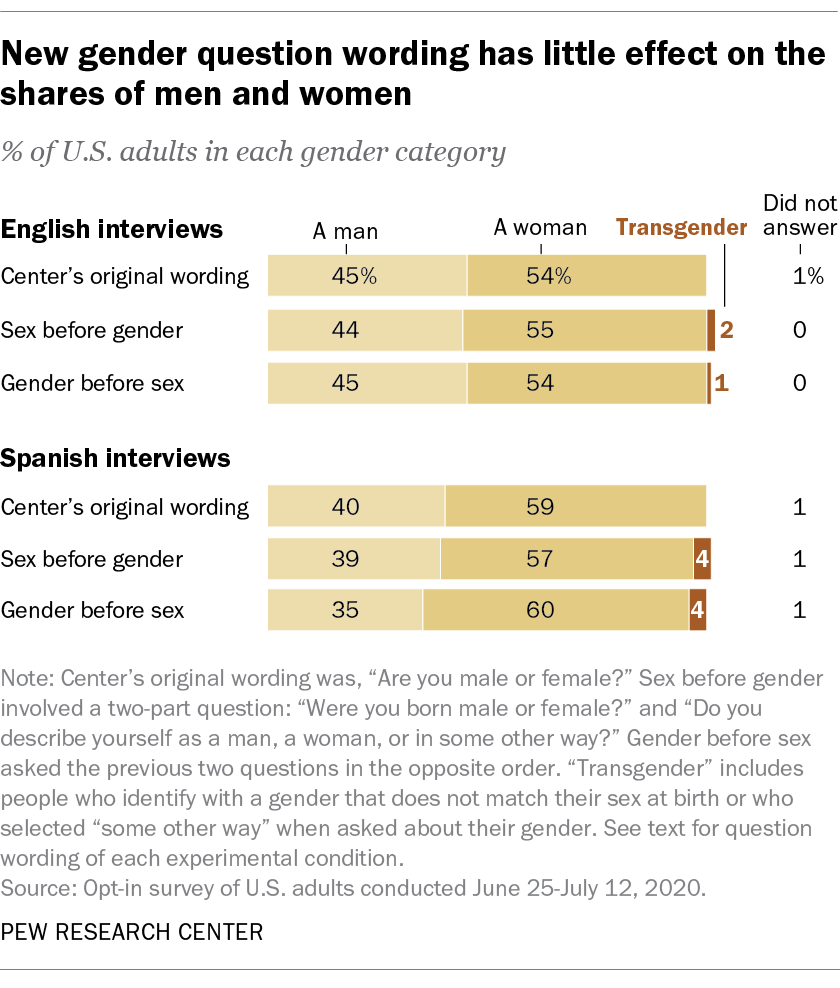
Data quality improved with the new gender question
Regardless of the way in which we asked respondents their sex/gender, we observed consistent distributions among men and women, suggesting little effect of the question wording for most people. However, among English-speaking adults who received the new gender questions, 1.5% selected the third, nonbinary response option or chose a gender inconsistent with their sex, suggesting that the inclusion of the third option had the intended effect on being more inclusive and improving data accuracy.
There was some concern that people who consider themselves a man or woman may not wish to be defined by their gender and instead opt for the third option and write in a non-gender term to describe themselves, such as “human” or “mother” or “scientist.” A large number of these types of responses would have suggested that the revised question would introduce error and hurt data quality. Luckily, we only observed four of these types of responses among English speakers, affecting the estimate by 0.1 percentage point and suggesting that it was not a problem.
Providing a third gender option didn’t alienate people
Fewer English-speaking respondents to our 2020 survey said they opposed the inclusion of a third gender response option on forms or online profiles (44%) than in our 2018 survey. However, 44% is still a substantial share of respondents. We were concerned that opponents would find our new, more inclusive question off-putting. This concern did not appear in the data. Fewer than 1% opted not to answer the gender question.
The revised gender question also didn’t cause more people to stop taking the survey before completing it. No more than 0.5% of English-speaking respondents across all experimental conditions opted to stop participating at or after the sex and gender questions.
The revised questions also did not appear to be affecting the Center’s credibility as a nonpartisan research organization. When asked whether respondents thought the survey was politically neutral, about three-in-four English speakers said the survey was not at all or not very biased, regardless of which gender questions they received.
The new gender question worked in Spanish, too
A small proportion of Spanish-speaking respondents (3.6%) opted for the third gender choice or chose a gender inconsistent with their sex. While this was significantly higher than the estimate among English speakers (1.5%), both English and Spanish speakers were asked to confirm their choice if sex and gender responses did not match. Spanish speakers consistently confirmed their answers to both sex and gender. Moreover, when asked if they found any questions confusing, only six Spanish speakers mentioned the gender question wording, and none of the six were coded as transgender.
Similar to English-speaking respondents, Spanish speakers did not seem to be affected by the various question wordings. And the addition of a third option had no perceivable alienation effect. Some 40% of Spanish speakers said they disapproved of the addition of a third gender choice on forms, but the addition of a third response category to the gender question did not cause more people to stop participating in the survey prematurely, nor did it affect the proportion of Spanish-speakers who perceived the survey as somewhat or very biased.
Asking about sex in addition to gender wasn’t necessary
While our experiment used a two-step question to deduce both a respondent’s sex and gender, moving forward, we will limit most of the Center’s U.S. surveys to the single gender question referenced at the top of this post.
Based on comments collected at the end of our experiment, fewer than 1% of respondents mentioned the sex and gender questions in any way. Among those who did, 30% expressed frustration over the presence of multiple questions or concern about the use of the term “born” in the question on sex. Also, the inclusion of a question about respondent’s sex isn’t necessary for most of the Center’s research, which focuses predominantly on gender. And while we do construct weights based on population estimates by sex, the correlation between gender and sex suggests that gender can reliably be used as a proxy for sex for this purpose. Another important consideration is respondents’ time: If we don’t need to ask a question, we won’t.
In conclusion, this change in how we ask about gender was not taken lightly, as we were driven to ensure inclusivity and accuracy while maintaining the rigorousness and neutrality that characterizes the Center.
Categories:
- Survey Methods
More from Decoded
Who are you the art and science of measuring identity.
As a shop that studies human behavior through surveys and other social scientific techniques, we have a good line of sight into the contradictory nature of human preferences. Here’s a look at how we categorize our survey participants in ways that enhance our understanding of how people think and behave.
How Pew Research Center will report on generations moving forward
When we have the data to study groups of similarly aged people over time, we won’t always default to using the standard generational definitions and labels, like Gen Z, Millennials or Baby Boomers.
5 things to keep in mind when you hear about Gen Z, Millennials, Boomers and other generations
It can be useful to talk about generations, but generational categories are not scientifically defined and labels can lead to stereotypes and oversimplification.
How a coding error provided a rare glimpse into Latino identity among Brazilians in the U.S.
An error in how the Census Bureau processed data from a national survey provided a rare window into how Brazilians living in the U.S. view their identity.
Why the U.S. census doesn’t ask Americans about their religion
The Census Bureau has collected data on Americans’ income, race, ethnicity, housing and other things, but it has never directly asked about their religion.
MORe from decoded
How pew research center is – and is not – using large language models in our work, what a survey experiment tells us about measuring religious tolerance in australia, measuring partisanship in europe: how online survey questions compare with phone polls.
To browse all of Pew Research Center findings and data by topic, visit pewresearch.org
About Decoded
This is a blog about research methods and behind-the-scenes technical matters at Pew Research Center. To get our latest findings, visit pewresearch.org .
Copyright 2024 Pew Research Center

How Should Market Researchers Ask About Gender In Surveys?
New gender identity research shows we need to rethink the answer..
Posted September 4, 2016
- Find a therapist who understands gender identity
Over the past decade, I have designed, commissioned, and analyzed dozens of market research surveys. They have varied on virtually every dimension. Some were short with a handful of questions. Others were long, taking half an hour or more to complete. Participants provided their answers using pencil-and-paper, over the telephone, in person, and more recently, online or with mobile apps. The surveys differed in questions asked, samples targeted, and incentives offered.
Why do we need more than two gender categories?
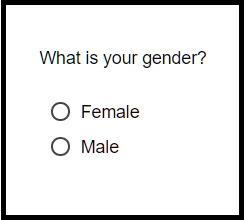
But they all had one thing in common: how I elicited the participant’s gender. In virtually every case, I gave participants two options to choose from, male or female (see adjacent figure). In a handful of instances, I might have provided a third category, “Prefer not to say”. (I also confused gender with sex , which distinguishes between people based on biological differences, but that is a topic for another day).
Recent social science research, and the rising consciousness of gender equality as a social issue highlighted by movements around the world indicate that a dualistic way of categorizing gender as male and female in market research is outdated. It’s not just ethically wrong , but even practically speaking, it is incorrect and a bad practice.
Transgender is a third important gender category
Looking beyond male and female gender identities, transgender individuals represent a significant number of the population. One June 2016 study conducted by researchers at the Williams Institute used CDC’s Behavioral Risk Factor Surveillance System data and estimated that 0.6% of all US adults, or about 1.4 million people, identify as transgender. This means in a typical market research survey of 500 participants, we would expect to find around 3 transgender respondents. In some specific location-based samples, the numbers are even higher (For example, the District of Columbia had a transgender identity rate of 2.8%).

Another study conducted by psychologists Kristina Olson, Aidan Key, and Nicholas Eaton found that “transgender children are not confused, delayed, showing gender-atypical responding, pretending, or oppositional — they instead show responses entirely typical and expected for children with their gender identity .” They concluded: “The data reported in this paper should serve as further evidence that transgender children do indeed exist and that this identity is a deeply held one.”
And finally, there are important practical reasons for measuring transgender identity directly. Social work researcher Taylor Cruz found that transgender and gender non-conforming Americans receive poorer medical care, partly because many large surveys failed to gather accurate data by masking differences between different consumer groups. Numerous studies show that transgender individuals are stigmatized and discriminated against . So it seems to me that not acknowledging and measuring transgender identity explicitly in a market research survey is yet another form of discrimination against transgender individuals.
Beyond the transgender category
It is clear we need to add a transgender category to the gender question in market research surveys. But should we consider other gender categories as well? At the moment, New York City recognizes a total of 31 gender identities . They include categories like agender, androgyne, bi-gender, gender fluid, and genderqueer. Along similar lines, Facebook introduced 58 options to specify gender in 2014 and gave its users the option to select a preferred pronoun to address them. Some psychology researchers, too, have argued for the inclusion of categories like intersex and genderqueer, but cautioned that the terms and definitions are still evolving. And survey designers are starting to add some of these categories to their surveys as well.
As of now, the views of experts on how many non-overlapping gender categories exist, whether an exhaustive list can be created, what each one exactly means, and whether gender non-conforming individuals can reliably classify themselves into one of these categories are still in flux. It seems to me that we are not still ready to provide an accurate list of gender identity categories to survey respondents to choose from.
My recommended question to elicit gender in market research surveys
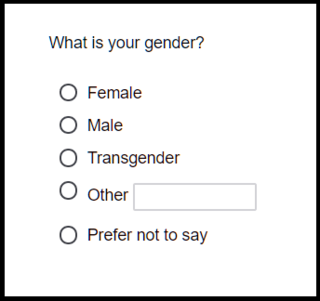
The state of the art advice on the question of how to elicit gender in surveys comes from a September 2014 report compiled by the Williams Institute titled “Best practices for asking questions to identify transgender and other gender minority respondents on population-based surveys.” It suggests using a two-step approach for surveys that are targeted toward transgender and other gender minority participants.

For broader user in market research surveys where gender may not necessarily be the study’s focus, I adapted their recommendation. I have designed the question in the adjacent figure that I have started to use in my surveys to elicit gender. My suggested question adds the transgender category as a third choice and a fourth category allowing respondents to write-in their gender. This approach is similar to Facebook’s option of a “Custom” gender box to be filled in by the user. And of course, the fifth and last option is a “Prefer not to say” for those respondents who may not want to reveal their gender to the market researcher.
Any well-designed market research survey is based on two core principles: the principle of accuracy and the principle of inclusiveness . A questionnaire should be designed to gather information accurately, using best practices of survey design that psychometricians have formulated over several decades. But this is not enough. A survey should also be inclusive. When a respondent has finished taking a survey, they should feel like the opinion they have provided will be valued just as much as every other survey-taker.
Business as usual, by asking the “What’s your gender?” question and providing only the “male” and “female” options to choose from violates both principles. It is an implicit endorsement of discrimination against transgender and gender non-conforming respondents. And in some cases, the analysis may end up masking differences between respondent groups (because gender was not elicited correctly). Using a five-category question to provide gender that allows respondents to choose from male, female, transgender, and other, categories, and the freedom to write-in a custom response if other is chosen, will increase both accuracy and inclusiveness of market research surveys.
Acknowledgment
I would like to thank Eric Gould Bear for bringing this question to my attention and for an interesting conversation on this topic.
I teach marketing and pricing to MBA students at Rice University . You can find more information about me on my website or follow me on LinkedIn , Facebook , or Twitter @ud.

Utpal M. Dholakia, Ph.D. , is the George R. Brown Professor of Marketing at Rice University.
- Find a Therapist
- Find a Treatment Center
- Find a Psychiatrist
- Find a Support Group
- Find Online Therapy
- United States
- Brooklyn, NY
- Chicago, IL
- Houston, TX
- Los Angeles, CA
- New York, NY
- Portland, OR
- San Diego, CA
- San Francisco, CA
- Seattle, WA
- Washington, DC
- Asperger's
- Bipolar Disorder
- Chronic Pain
- Eating Disorders
- Passive Aggression
- Personality
- Goal Setting
- Positive Psychology
- Stopping Smoking
- Low Sexual Desire
- Relationships
- Child Development
- Self Tests NEW
- Therapy Center
- Diagnosis Dictionary
- Types of Therapy

It’s increasingly common for someone to be diagnosed with a condition such as ADHD or autism as an adult. A diagnosis often brings relief, but it can also come with as many questions as answers.
- Emotional Intelligence
- Gaslighting
- Affective Forecasting
- Neuroscience
- (855) 776-7763
Training Maker
All Products
Qualaroo Insights
ProProfs.com
- Get Started Free
FREE. All Features. FOREVER!
Try our Forever FREE account with all premium features!
How to Create Thoughtful & Inclusive Gender Survey Questions
Author & Editor at ProProfs
Shivani Dubey specializes in crafting engaging write-ups and exploring the intricacies of customer experience management. She covers vital topics such as customer feedback, voice of the customer (VoC), NPS, emerging UX and CX trends, and sentiment analysis.

Have you ever felt the frustration of trying to fit yourself into a box that doesn’t quite capture who you are?
Now, imagine encountering this every time you take a survey. As society evolves to recognize the beautiful complexity of gender, our surveys need to evolve from the binary options of “male” & “female” too.
But why do gender survey questions matter?
Well, for one, having an accurate idea of your survey takers’ identities is essential if you want precise market research data. It also helps foster a more inclusive environment in workplaces and educational institutions, leading to a happier, more productive workforce.
In this blog, we’ll explore how to create questions that respect and acknowledge the diverse spectrum of gender identities, along with their pros, cons, and best practices.
How to Create a Survey Using ProProfs Survey Maker
What Are Gender Survey Questions?
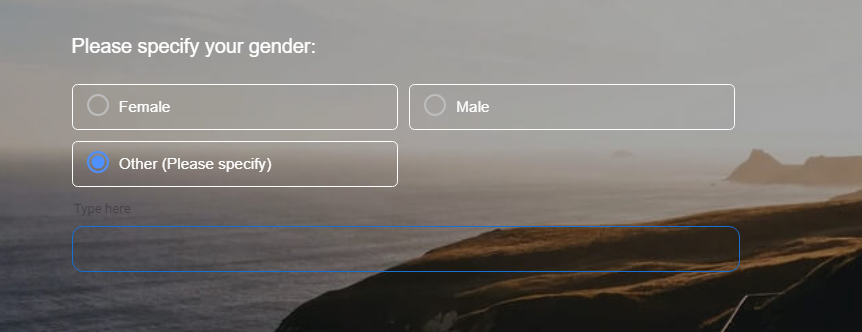
Gender survey questions are tools used in surveys and questionnaires to collect information about a person’s gender identity. Unlike traditional questions that only offer “male” or “female” options, these questions are designed to be inclusive and reflect the diverse spectrum of gender identities.
They might include options like “non-binary,” “genderqueer,” and “prefer to self-describe,” allowing respondents to represent their gender accurately.
While commonly used in demographic surveys, gender questions are also used in various other research fields, such as business and social sciences. They help evaluators see how (or if) respondents’ gender might influence their choices and behaviors and make it easier to spot underlying patterns.
How to Ask About Gender in a Survey
In a survey, questions that make recipients feel seen and included can be powerful motivators to draw a response. A survey that generalizes genders under binary categories can discourage survey takers who don’t identify with any of the options from answering.
When asking about gender, being inclusive, respectful, and clear is key. Here’s how you can craft questions that resonate with everyone:
1. Use Inclusive Options : It’s crucial to recognize that gender is not limited to “male” and “female.” Including a broader range of options allows respondents to represent their identities accurately. Some additional options might include “non-binary,” “agender,” “genderqueer,” “genderfluid,” and “prefer to self-describe.” This inclusivity not only shows respect but also improves the accuracy of your data.
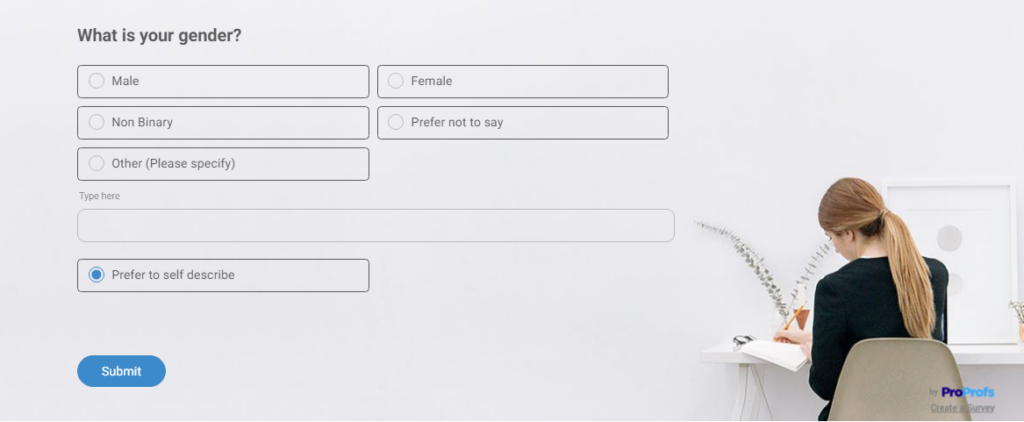
2. Provide an Open-Ended Option : Sometimes, predefined categories may not capture everyone’s identity. Including a “prefer to self-describe” option allows respondents to describe their gender in their own words. This flexibility ensures that everyone can express their true identity. 3. Respect Privacy : Gender identity is a personal matter, and not everyone may feel comfortable disclosing it. Including an option like “prefer not to say” allows respondents to skip the question if they choose, ensuring they don’t feel pressured to reveal personal information. 4. Be Clear and Sensitive : When framing your question, use respectful language and avoid assumptions about gender. Ensure that your question is easy to understand and considers the diverse experiences and identities of your respondents. 5. Explain Why : Provide context for why you’re asking about gender. This will help respondents understand the importance of the question and how their answers can impact the interpretation of the survey data.
Why Should You Ask Questions About Gender in a Survey?
According to a Pew Research Center survey , about 42% of Americans believe forms and online profiles should offer gender options beyond “man” and “woman” for those who don’t identify as either.
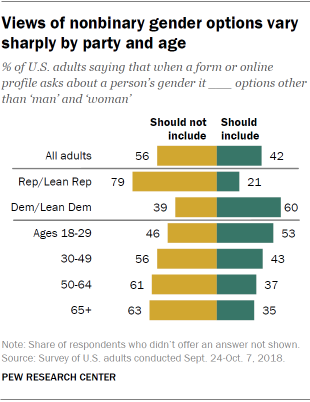
Source: Pew Research Center
This rising consciousness of inclusivity demands an accurate representation of survey takers for clearer, more accurate data.
Here’s a detailed list of all the reasons why offering diverse gender choices on forms is a crucial step:
- Inclusivity : By providing more gender options, you ensure that all respondents feel recognized and respected, which can lead to higher engagement and more accurate responses.
- Accurate Data Collection : Understanding the diverse gender identities of your respondents helps with more precise data analysis, helping to identify trends and patterns that might be overlooked with limited options.
- Better Decision-Making : For businesses, inclusive gender data can inform marketing strategies, product development, and customer service practices, ensuring they meet the needs of all customers.
- Social Awareness and Progress : Including diverse gender options in surveys raises awareness about gender diversity and supports the broader movement toward social acceptance and equality.
- Workplace Inclusivity : In organizational settings, understanding the gender diversity of employees can aid in creating more inclusive policies and a supportive work environment.
What Are the Pros and Cons of Using Gender Questions in Surveys?
While gender inclusivity in surveys comes with a lot of perks, it is not entirely devoid of shortcomings either. Let’s explore both in detail:
- Inclusivity and Representation : When you offer a range of gender options, everyone feels seen and respected. This can lead to more people participating and giving honest answers.
- Accurate Demographic Data : Knowing the diverse gender identities of your respondents helps you get a clearer picture and understand your audience better.
- Informed Decision-Making : For businesses and organizations, having inclusive gender data means you can tailor your products, marketing strategies, and customer service to meet the needs of all customers.
- Policy Development : Understanding gender diversity in your organization helps in crafting policies that create a supportive and inclusive environment for everyone.
- Social Awareness and Progress : Asking about gender diversity helps raise awareness and supports the movement toward greater acceptance and equality.
- Tailored Services : When you know more about the gender identities of your respondents, you can better design services and interventions that truly meet their needs.
- Privacy Concerns : Some people might feel uncomfortable sharing their gender identity, which could make them hesitant to complete the survey.
- Misinterpretation or Offense : If gender questions aren’t phrased thoughtfully, they can offend or confuse respondents, leading to skewed data.
- Complexity and Length : Adding more gender options can make the survey longer and more complex, potentially putting off some respondents.
- Data Sensitivity : Gathering gender data means you need to handle it carefully to protect confidentiality and privacy, which adds responsibility.
- Cultural Differences : In some regions or cultures, gender diversity might not be widely accepted or understood, which could lead to confusion or backlash.
- Potential Bias : If gender questions aren’t well-designed, they can introduce bias, affecting the accuracy and reliability of your data.
Best Practices for Asking Gender Questions in a Questionnaire
Gender is a sensitive topic for many, and knowing how to pose the questions without disrespecting respondents is key to getting accurate responses and increasing the survey completion rate. Here are some best practices to follow while crafting your questionnaire:
1. Use Inclusive Language :
- Ensure your options reflect a range of gender identities beyond “male” and “female.”
- Prefer to self-describe: __________
- Prefer not to say
2. Provide an Open-Ended Option :
- Allow respondents to describe their gender in their own words if they don’t identify with the listed options.
- Example: “Prefer to self-describe: __________”
3. Respect Privacy :
- Include an option for respondents who prefer not to disclose their gender.
- Example: “Prefer not to say”
4. Be Clear and Sensitive :
- Use respectful and non-assumptive language.
- Avoid terms or phrasing that might be confusing or offensive to respondents.
5. Explain the Purpose :
- If possible, explain why you are asking about gender. This transparency can help respondents understand the importance of the question.
- Example: “We ask about gender to ensure we are inclusive and to better understand the needs of all our participants.”
6. Position the Question Thoughtfully :
- Place the gender question in a logical position within the survey, such as alongside other demographic questions.
- Avoid placing it at the very beginning if you think it might cause discomfort.
7. Test Your Questions :
- Before finalizing the survey, test your gender question with a diverse group to ensure it is clear, inclusive, and respectful.
- Collect feedback and be open to making adjustments based on this feedback.
8. Avoid Mandatory Responses :
- Do not make the gender question mandatory, as this can make some respondents uncomfortable and lead to incomplete surveys.
9. Stay Updated :
- Gender identity language and best practices evolve. Regularly review and update your survey questions to stay current with inclusive terminology and practices.
10. Be Culturally Sensitive :
- Be aware of the cultural context of your respondents. In some cultures, gender diversity might be understood differently, and you may need to adjust your questions accordingly.

Gather Meaningful Data With Rightly Placed Gender Survey Questions
Gender questions in surveys aren’t just a box to tick—it’s about making sure everyone feels seen and respected. Inclusive gender options, open-ended responses, and privacy respect are crucial to making respondents comfortable and your data accurate.
Explain why you’re asking these questions, and place them thoughtfully in your survey. Keep your questions updated to reflect current language and cultural contexts.
Good gender questions mean better data, leading to smarter decisions and more inclusive policies. When you prioritize inclusivity, you create respectful and insightful surveys that benefit everyone involved.
If you are unsure where to start, a tool like ProProfs Survey Maker with an AI survey generator and readymade templates can be your best bet. You can automatically create a questionnaire, customize it with your questions and brand themes, and share it instantly wherever or however you like.
About the author
Shivani Dubey
Shivani Dubey is a seasoned writer and editor specializing in Customer Experience Management. She covers customer feedback management, emerging UX and CX trends, transformative strategies, and experience design dos and don'ts. Shivani is passionate about helping businesses unlock insights to improve products, services, and overall customer experience.
Related Posts

How to Use Screening Survey Questions Like a Pro

Proven Tips to Avoid Leading and Loaded Questions in Your Survey

What Is Quantitative Research? Types, Characteristics & Methods

Course Evaluation Survey: Questions & Tips to Create

How to Write Crucial Return to Work Survey Questions

20+ Best Software Survey Questions to Ask Your Customers in 2024
Copyright © SurveySparrow Inc. 2024 Privacy Policy Terms of Service SurveySparrow Inc.
How to Ask the Right Gender Survey Questions on Sexual Orientation & Gender Identity
Aysha Muhammed
Last Updated: 24 June 2024
11 min read

Table Of Contents
- Introduction
What are Gender Survey Questions?
Why must you include more than two gender options in your survey, why should you ask gender in a survey, how do you ask about gender in a survey, 20+ gender survey questions to ask in a survey, tips for asking mindful gender survey questions.
- Gender survey questions: Best practices
- Mistakes to avoid
- How can SurveySparrow help?
- Wrapping Up
If someone requested you to fit into a precise criteria or box that doesn’t truly represent who you are, would you rather do so?
It’s essentially a big no, right? We’ve all felt the strain of trying to fit into predetermined boxes, classifications, and criteria of who we truly are.
On the same note, I was wondering how it would feel if there were not enough gender options each time we take a survey. In the wake of the ever-evolving gender spectrum, we’ve come a long way from being perplexed about identities, unlearning certain stereotypes, and accepting more inclusive things.
But why do gender questions matter, and where will they be useful?
Meanwhile, if you’re here for a set of gender survey questions, create a demographic or gender-based survey, jump into questions right below.
- 20+ Gender Survey Questions-Examples
Looking for an example gender survey template? I’ve got that figured out, too.
Sign up with your email and get an already built gender survey template for free. You can customize it the way you want and start using it for free.
14-day free trial • Cancel Anytime • No Credit Card Required • No Strings Attached
Now to the basics.
One of the survey question types, a gender survey question, is used to gather the gender of a respondent. Although these questions are commonly employed in a demographic survey, they are also widely used in several other types of research, such as business, social science, etc.
Gender survey questions basically help the evaluators understand if and how the respondents’ gender affects the choices and assist in identifying patterns, if any. While “male” and “female” remained the only plausible choices among survey makers, it’s no longer the case today.
Case in point, with changing norms around gender identity, people no longer shy away from answering gender questions if they feel they’re relevant to the demographic survey.
(Related: The 10 Best Demographic Survey Questions You Need to Ask )
In a 2015 study, scholars Laurel Westbrook and Aliya Saperstein, in their “ New Categories Are Not Enough: Rethinking the Measurement of Sex and Gender in Social Surveys,” elaborate on the driving need to reflect on the diversity of gendered lives and better align survey measurement practice with contemporary gender theory.
In a more recent study by Pew Research Centre, four in ten (42%) U.S. adults demand that when they’re presented with a form that asks about their gender, it should include options other than “man” and “woman.”
These data only indicate the rising consciousness of gender inclusivity and the demand for improving data accuracy by means of accurate data representation. If you don’t move along this hyper-gendered world, your survey results will remain erased of essential dimensions and will perpetuate inequality.

Asking about gender in a survey can be important for several reasons:
- Data Accuracy and Representation : Understanding gender demographics helps accurately represent and understand the survey population. It ensures that the data reflects the diversity of the group being surveyed.
- Informed Decision-Making : Gender-specific data can inform policies, programs, and services that address specific needs or disparities among different gender groups.
- Research and Analysis : For research purposes, gender data can be crucial in studying trends, behaviors, or issues that may vary by gender.
- Inclusivity and Awareness : Including gender questions significantly beyond the binary options promotes inclusivity and raises awareness about gender diversity.
To ask about gender in a survey effectively and inclusively:
- Offer Multiple Options : Include diverse gender identities beyond the binary male/female. Options like non-binary, transgender, intersex, and an option for self-description can be included.
- Use Clear Language : Ensure the wording is clear and respectful. Avoid using technical terms or jargon that might not be very clear.
- Include a ‘Prefer Not to Say’ Option : This respects the privacy of respondents who may not wish to disclose their gender.
- Consider the Purpose : Only include gender questions if they’re relevant to the survey’s goals. Unnecessary questions about gender can be intrusive.
- Skip and Branch Logic : Implement skip and branch logic to tailor the survey experience. Skip logic allows respondents to bypass irrelevant questions based on gender selection, while branch logic presents tailored follow-up questions according to the chosen gender identity.
- Be Mindful of Privacy and Sensitivity : Recognize the personal nature of gender identity and ensure confidentiality and respectful data handling.
Remember, the approach should always be respectful and mindful of your respondents’ diverse experiences and identities.Now, let’s explore some of the examples of how you should curate questions based on gender.
As American University accurately puts it, “Often the questions are asked because we feel like they should be asked, or because we consider them ‘standard’ demographic questions, not because the data are necessary for cross-tabulation.”
But if you’re confident that gender is an important data point for your survey and want to explore the many ways in which you can add gender questions to your survey, here are some pointers to get started:
1. What is your gender?
- I prefer not to say
- Self Descriptive
2. What is your sex?
3. How do you identify your sexual orientation?
- Heterosexual (straight)
- Homosexual (gay/lesbian)
- Other (please specify)
4. What pronouns would you prefer to use?

5. How comfortable do you feel expressing your gender identity in public spaces?
- Very comfortable
- Somewhat comfortable
- Somewhat uncomfortable
- Very uncomfortable
6. Is your workplace/ school gender inclusive?
7. Have you faced gender discrimination or bullying in your school or workplace?
- Prefer not to say
8. How do you perceive societal attitudes toward non-binary individuals?
9. How confident are you to embrace your gender identity?
10. On a scale of 1-10, how comfortable and confident are you to discuss your gender identity at your workplace?
11. Have you ever had sex education at your school regarding gender identity and awareness?
12. Do you find it difficult to come out and embrace your gender identity?
13. Do you believe that your opinions on gender have changed over the past five years?
14. At what age did you become aware of your gender identity?
15. Are you aware of the LGBTQ+ Support organizations for Queer community?
16. Are there gender-neutral restrooms in your locality?
17. Are people around you generally supportive or understanding of Gender orientations?
18. What steps should society take to be more gender inclusive of diverse gender categories?
19. Please share any personal experiences related to your gender identity.
20. What is the biggest challenge facing individuals as they explore their gender identity?
- Use Inclusive Language : Provide options beyond the traditional male/female binary, such as non-binary, transgender, and an open-ended option for self-identification.
- Respect Privacy : Include an option like ‘Prefer not to say’ for those who wish to keep their gender identity private.
- Purpose of the Question : Ensure the gender question is relevant to the survey’s objectives and is asked to gather necessary information rather than out of curiosity.
- Confidentiality : Assure respondents that their information will be confidential and used responsibly.
- Avoid Assumptions : Do not make assumptions about the respondent based on gender identity.
- Clear Instructions : Provide clear instructions on answering the question, especially if using open-ended or multiple-choice formats.
- Sensitivity Training : Ensure that those analyzing the data are trained to understand gender diversity and the implications of gender-related data.
- Include Non-Binary Gender Options : Specifically acknowledge non-binary identities by providing a non-binary option. This recognizes and respects individuals who do not identify exclusively as male or female, ensuring their representation and inclusion in survey data.

Approaching gender survey questions: Best practices
Whatever gender options you have considered and then decided on using in your survey, you still need to ask these questions correctly to gain the most value from their use. Here are some pointers to consider in the process-
I understand why you’re asking about gender in the first place
Grasping the motive for asking the gender question is a crucial part of the process. Keep your target audience and data-analysis goal in mind while framing the questions.
Throughout the process, you’ll want to weigh in on your information needs and how your respondents will perceive the question. Enough said, you can safely skip these questions unless it is not needed for your data analysis.
If you decide to ask the question, remember to tread carefully
In all earnestness, gender is often a sensitive and misunderstood subject. That’s why it’s important to reflect and introspect on questions such as
- Why are you collecting this information?
- What is the business rationale behind asking about gender in this form?
- How will the information collected be utilized?
- Do you have any legal restrictions on collecting and storing this data?
You also want to be careful not to have it mangled loosely with often wrongly interchanged terms such as “sex” or “sexual orientation.” Doing this will enrage your respondents and force them to opt out of the survey instantly.
Mistakes to avoid while asking gender survey questions
“Do it less, and we have a problem; overdo it, and you’ll find yourself with a bigger problem at hand” is how we can best describe this use case. As much as inclusivity is indispensable, it should not happen at the cost of fatiguing your survey respondents.
On that note, here are gender survey questions to avoid:
- Giving too many options: The peril of over-asking is real. Creating a massive list of options will tire your respondents before you know it.
- Giving too few options: If the broader options weren’t bad enough, being a stickler for the binaries will also negatively affect you.
How can SurveySparrow help create a perfect gender survey questionnaire
To effectively use the SurveySparrow gender survey questionnaire:
- Customize questions to suit your specific survey goals, ensuring they are inclusive and respectful of all gender identities.
- To gather comprehensive data, utilize various question types offered by SurveySparrow, like multiple-choice or open-ended formats.
- Use SurveySparrow’s user-friendly design to create an engaging survey experience, potentially increasing response rates.
- Implement privacy features to ensure respondent confidentiality, which is especially for sensitive topics like gender identity.
- Analyze the data using SurveySparrow’s analytics tools to gain insights and inform decision-making processes.
Ask the right gender survey questions on gender identity and sexual orientation
Sign Up with SurveySparrow for Free & Get 40% More Higher Response Rates
14-Day-Free Trial • Cancel Anytime • No Credit Card Required • Need a Demo?
Wrapping up
Asking about gender in your survey isn’t always necessary. But sometimes, most times, when included, it contributes to the richness of data.
Now that more and more people are comfortable with their gender identity and sexual orientation, there has never been a better time to collect them. In fact, when researchers at the Census Bureau conducted an experiment asking respondents how they felt responding to the question on gender, nearly everyone(90%, to be exact) said they were comfortable answering them.
With a survey tool such as SurveySparrow, approaching gender survey questions is made easier than ever. With pre-made templates for every use case, versatile question types, and a conversational interface, you get to send out thoughtful surveys that resonate with your audience.
Part-time hermit and a full-time writer trying to survive the SaaS space, one blog at a time. Bylines in digital but always on deadline.
You Might Also Like

22 Best Employee Pulse Survey Tools of 2024

How To Measure Customer Feedback With Semantic Differential Scale

Customer Experience
What is Customer Experience Marketing: Key Strategies and Practices

Help!! Save Princess Leia From The Evil Hutts
Turn every feedback into a growth opportunity.
14-day free trial • Cancel Anytime • No Credit Card Required • Need a Demo?
- Form Builder
- Survey Maker
- AI Form Generator
- AI Survey Tool
- AI Quiz Maker
- Store Builder
- WordPress Plugin
HubSpot CRM
Google Sheets
Google Analytics
Microsoft Excel
- Popular Forms
- Job Application Form Template
- Rental Application Form Template
- Hotel Accommodation Form Template
- Online Registration Form Template
- Employment Application Form Template
- Application Forms
- Booking Forms
- Consent Forms
- Contact Forms
- Donation Forms
- Customer Satisfaction Surveys
- Employee Satisfaction Surveys
- Evaluation Surveys
- Feedback Surveys
- Market Research Surveys
- Personality Quiz Template
- Geography Quiz Template
- Math Quiz Template
- Science Quiz Template
- Vocabulary Quiz Template
Try without registration Quick Start
Read engaging stories, how-to guides, learn about forms.app features.
Inspirational ready-to-use templates for getting started fast and powerful.
Spot-on guides on how to use forms.app and make the most out of it.
See the technical measures we take and learn how we keep your data safe and secure.
- Integrations
- Help Center
- Sign In Sign Up Free
- How to write gender questions in your surveys: Tips & examples

Ayşegül Nacu
In research and data collection, gender identification has grown in importance. Many survey writers still have difficulty properly writing questions on gender, though. Also, understanding distinct groups' needs, actions, and opinions largely depends on surveys.
Poorly designed gender questions might result in erroneous or partial data that does not accurately reflect the whole range of gender identity. The best methods for formulating gender questions that are understandable, considerate, and inclusive of various gender identities will be covered in this article.
- Why do you need to be careful when writing and asking gender questions?
Since gender is a sensitive and private subject for many people, it is imperative to take caution when writing about and posing gender-related topics. Our cultural, social, and personal experiences can impact how we define ourselves . Beyond the superficial classifications of male and female, gender is a complex concept.
In addition to being unpleasant and insulting, using the wrong pronouns or making assumptions about someone's gender identity can cause them to feel rejected and alienated. It's crucial to respect each individual's gender identity and to refrain from inferring gender from someone's appearance, name, or any other trait.
What’s the difference between sex and gender?
While they are sometimes used interchangeably, the terms " sex " and " gender " identity relate to an individual's different aspects. This confusion can result in misconceptions and feed negative biases and stereotypes. We may try to create a culture that is more inclusive and tolerant by encouraging knowledge and education about the distinctions between sex and gender.
- The biological and physiological traits that distinguish males and females are referred to as “sex.” They consist of hormones, chromosomes, and reproductive organs.
- Typically, a person's sex is determined by their reproductive system and the chromosomes their parents gave them. We can say that sex is assigned at birth .
On the other hand, gender refers to the social and cultural roles, behaviors, expectations, and identities associated with the male and female genders. It includes a variety of qualities, like one's self-identification as male, female, or non-binary. Gender identity is an individual's internal perception of gender.
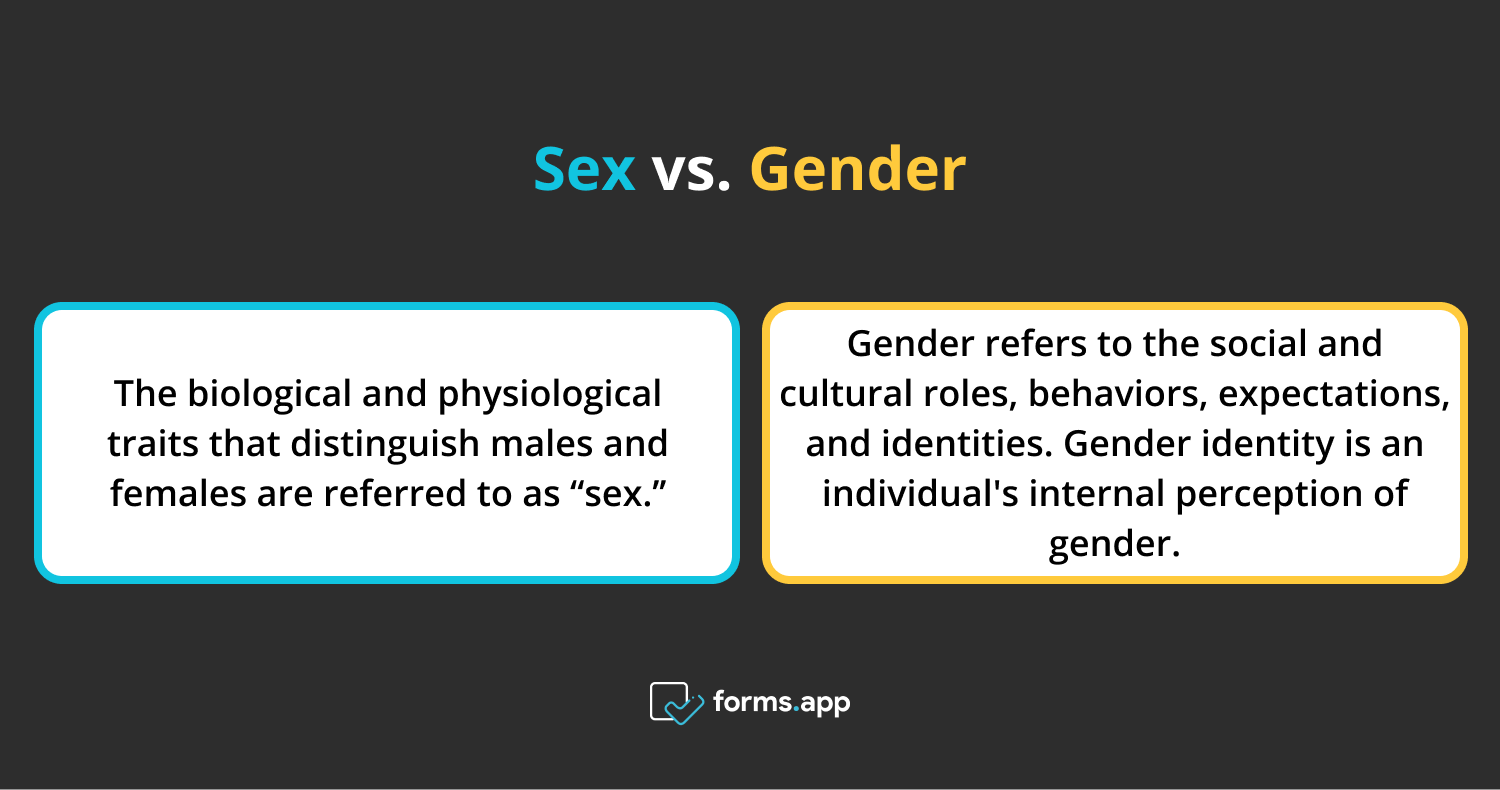
The difference between sex and gender
- Two ends of the spectrum: Mistakes to avoid in gender questions
There are two extremes on the gender spectrum that ought to be avoided while discussing them. Too many gender options are the first error to avoid. Using only two alternatives is another error to avoid when asking a question about a person's gender, though.
Adding too many options
While it's crucial to have a variety of gender-inclusive alternatives, having too many might be burdensome and confusing for participants. This may potentially result in inaccurate data and troublesome analysis . So, it's imperative to establish a balance between inclusivity and pragmatism.
Example: Which of the following gender identities do you most closely identify with?
a) Male
b) Female
c) Agender
d) Transgender
e) Androgyne
f) Bigender
g) Butch
h) Cisgender
i) Cishet
j) Demigirl
k) Demiboy
l) Genderfluid
m) Omnigender
n) Polygender and pangender
o) Other
Using only two options
Male and female, the two conventionally accepted gender binary alternatives, do not take into consideration the diversity of gender identity and may insult non-binary people. Non-binary and genderqueer alternatives are crucial for being inclusive and supportive of all gender identities. By not doing so, statistics may be distorted, and some groups may be underrepresented.
Example: What gender do you identify as?
- What to consider when writing gender questions?
Whether creating surveys, questionnaires, or any other type of data collection, the style of questions is critical, especially when it comes to gender. In order to avoid exclusion or bias towards any gender identity, asking questions regarding gender is a delicate topic that requires careful attention. It would be useful to add questions as options. Including options for gender identity can help promote awareness and education about the diversity of gender identities that exist.
- Consider the context: The context in which the gender question is being asked is essential to consider. For example, asking for gender on a job application may require different options than asking for gender in a survey about personal identity.
- Include open-ended questions: If the available alternatives do not adequately express the survey takers’ opinion on the gender-related topic, consider enabling them to type in their own response options.
- Avoid asking questions that aren't essential: It might be invasive and uncomfortable for respondents to be asked questions about their gender that aren't necessary for the data gathering.
- Use gender-neutral language: There are more aspects of gender than just male and female, and this situation demonstrates respect for people's gender identities. Regardless of a person's gender identification, this can help create a more friendly and tolerant environment (e.g., " they " or " them ").
- 5 Question examples about gender
We mentioned that it is critical to tackle gender issues with compassion and respect in order to ensure that all gender identities are appropriately portrayed. In this article, we have included 5 sample questions to give you a hint.
1 - How would you describe your gender identity? (Single selection)
c) Transgender
d) Non-binary
e) Genderqueer
f) Other
2 - What effects do you believe gender norms in society have had on your experiences? (Long text)
3 - How important is it to you that your friends and family use your preferred pronouns? (Single selection)
a) Very important
b) Important
c) Not very important
d) Not at all important
4 - What steps should be taken, in your opinion, to make society a more welcoming and equal place for people of all gender identities? (Multiple selection)
a) By fostering knowledge of and sensitivity to the range of gender identities
b) By promoting laws that defend and assist people with all gender identities
c) By opposing detrimental gender preconceptions and conventions
d) By offering assistance and resources to anyone who has encountered harassment or discrimination because of their gender identity
e) Other
5 - On a scale between 1-5, how comfortable are you discussing issues related to gender with others? (Opinion scale)
- Wrapping it up
It is critical to recognize that gender is a nuanced and diverse aspect of identity and that questions should reflect this diversity and complexity. Since people's attitudes on gender continue to shift, survey researchers should explore new ways to pose gender-related questions that reflect the changing nature of gender identity and create greater understanding and inclusivity.
With these guidelines and examples, survey designers can create gender-related questions that are both practical and inclusive, resulting in a better understanding of the needs and experiences of people of various gender identities.
Ayşegül is a content writer at forms.app and a full-time translation project manager. She enjoys scrapbooking, reading, and traveling. With expertise in survey questions and survey types, she brings a versatile skill set to her endeavors.
- Form Features
- Data Collection
Table of Contents
Related posts.
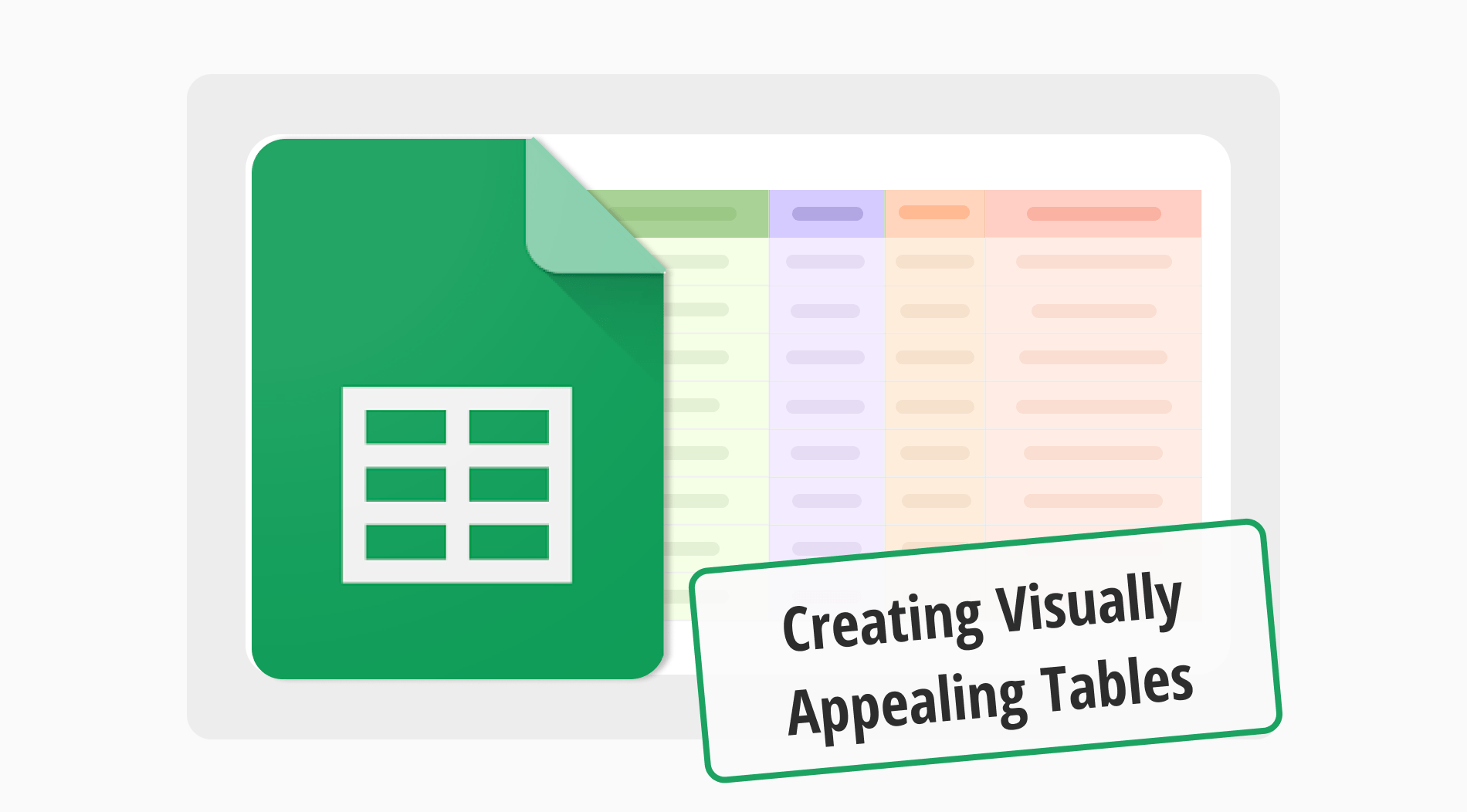
How to create visually appealing tables in Google Sheets
Behçet Beyazçiçek

How to create quizzes for your website
Defne Çobanoğlu

The best survey tools for 2024
forms.app Team
How to improve gender inclusivity for survey participants in market research
2021-07-30 Industry Trends Market Research Thought Leadership
Broadly speaking, the purpose of market research is to learn more about people. Traditional research practices tend to categorize different groups to gain a clearer picture of demographic data. In fact, it’s almost a requirement of the job – the goal is often to understand what X demographic feels about Y topic.
But what happens when people don’t fit into the categories we’ve come to rely on? And what happens when people don’t fit into the gender categories we’ve created, with gender being one of the most common data points that researchers use?
The world’s perception of gender is changing
As Whitney Dunlap ( Insights in Color ) writes in her article Why No One Listens When We Tell Them Who We Are , “The state of identity in America and across the world is in flux and no one seems completely sure what to do about it, or how to handle it.” Gender identity is evolving rapidly, yet market research standards are hardly keeping pace.
Nonbinary gender identity (people who do not identify as male or female) has gained more visibility worldwide, and different sectors have refined their practices to be more inclusive. For example, many states have added “nonbinary” as a gender option on birth certificates and state ID cards to more accurately reflect the gender spectrum. The world is changing and, as industry leaders, it is our responsibility to be proactive and intentionally inclusive in market research.
Where gender inclusivity is lacking in market research
Like many other industries, research is reflecting on its current practices and identifying areas of improvement. One key area we’ve found is around survey qualifying questions and how survey participants are asked to state their gender identity.
Market research (and most other demographic research) has traditionally defaulted to the demographic definitions used by the US Census in order to understand personal identity.
As has become abundantly clear, some of these “traditional” labels do not represent the current US population in every scenario, and they were never meant to understand the dynamic and complex nature of human identity.
Note: Thus far we’ve focused on the US, but we look forward to rolling out additional updates in other markets as well.
The benefits of inclusive gender representation
Changing the way we ask respondents to align with a gender identity benefits everyone involved – survey respondents, researchers, and end-clients.
From the perspective of a survey respondent, this is a critical moment to build positive relationships with them in the very first questions of the survey. Building that connection can give the respondent the safety to answer honestly throughout the rest of the survey. Additionally, forcing a respondent into a category they don’t fit in (a “male” or “female” gender identity) on the very first question could turn the respondent off from online surveys forever.
From a sampling perspective, we are freeing ourselves from an inaccurate understanding and bias of what it means to be “census representative.” As we update our language to be more inclusive and dynamic, we can hope to gain more representative viewpoints from real and properly identified people. If we maintain a false understanding of those categories, we accidentally bias our data, which leaves major gaps in research that is used to make important decisions.
Long story short, respondents will thank us for it, and so will business decision makers who will gain a deeper understanding of who their target markets are.
Steps we are taking to expand gender inclusivity
Lucid (a Cint Group company) is taking this moment to push ourselves and our industry to move past the historic tradition of forcing people into boxes that they don’t relate to. We instead aspire to allow users (People) to identify themselves as they see fit.
After working together with Insights in Color and ThinkNow Research to better understand best practices and modern identity traits, we are changing the way we ask these demographic identity questions: Ethnicity, Sexual Orientation, and Gender. Read the detailed updates and the context around them by downloading this PDF from Insights in Color . You can also learn more in this podcast episode with ThinkNow.
These changes may seem small, but represent a large shift in mindset on how we interact with our respondents. We encourage you to share this with your industry partners, implement as much as you can, and give us feedback on what we’re missing. Like identity and language itself, these definitions continually evolve so we look forward to continuing the conversation.
More from our blog

Introducing Women@Cint
Cint is committed to making ourselves a more diverse and inclusive workforce. Here’s how we’re making that happen.

Cint looks to the future of Lucid Measurement by using Unified ID 2.0 for advertisers to measure brand lift.
To support privacy-conscious ad exposure and diversify available identity solutions for brand-lift measurement, Cint is excited to enable Unified ID 2.0 (UID2) for Lucid Measurement on UID2-supported demand-side platforms like The Trade Desk.

CintSnap takes a deep dive into the 2024 Formula One World Championship frenzy.
It might be the world’s premiere motorsport, but has F1 truly caught the attention of audiences in the US, UK and Australia?
Other MRS sites
Research Jobfinder
The No.1 jobs resource for research and insight professionals

Research Buyer's Guide (RBG)
The only source of accredited research suppliers in the UK and Ireland
- Research Live
The definitive source of research news and opinion
- International Journal of Market Research (IJMR)
The world authority on research methodologies and techniques
The Fair Data mark helps consumers recognise who they can trust
- Geodemographics (GKB)
For people interested in the application of geodemographics and big data
Recruiter Accreditation
The RAS website provides training materials for use by qualitative research recruiters.
Update your password, personal details and email preferences.
Access member services and content.
We offer a wide range of events to drive innovation, host debate, recognise through awards and connect you with other research professionals.
- About membership
- Member benefits
- Member stories
- Membership grades
- How to join
- Terms & conditions
- My membership
- Member directory
- Fellows, Patrons & Honours
- Renew your membership
Company Partner
Company Partner Accreditation demonstrates your organisation's commitment to quality insight while keeping your business compliant, upskilled and competitive.
- Company Partner Accreditation
- How to get accredited
- Company Partner benefits
- Search Company Partners
- New Company Partners
- The ACP Council
- International Affiliate
- Employee benefits
- Operations Network
- Company Partner Login
Initiatives
MRS focuses on the leading issues that are important to the evolution of the industry, and topics of high relevance to clients and users of research.
- Research heroes
- Cost of living
- Sustainability
- Census and geodemographics
- Advanced Insights and Analytics
- People & Talent
- Global data quality
- Research Inside
- Inclusion and diversity
- Polling and media
- Government procurement
- Mobile optimisation
- Mental wellbeing
- Hidden homelessness
- MRSpride – LGBTQ+ network
- &more - young researchers network
- MRS Unlimited
- B2B Network
- Social Equity Group
- ADA Network
MRS champions the highest ethical, commercial and methodological practices in research.We provide fair regulation, clear guidance and practical advice. We help research flourish.
Professional standards
- Code of Conduct
- Binding Guidelines
- MRS Guidance
- Code of Conduct for Elections
Quality standards
- Other standards
Legislation
- Data protection
- Freedom of information
- AI regulation
- Policy & Data protection
- Policy & Standards review
Complaint handling
- MRS Disciplinary Authority
- How to complain
- Recent complaints upheld
- Sugging and Frugging FAQ
Research participants
- Been contacted by a research agency? (Freephone)
- Global Insight Academy
The MRS Global Insight Academy upskills over 2,000 professionals each year from over 30 countries. With the widest range of courses and qualifications available globally in research, insight and analytics, we provide you with expert development wherever you are in the world.
- Brand new courses
- Free taster courses
- Face-to-face courses
- Search all courses
- Courses by A-Z
- Courses by month
- Terms & Conditions
- Conferences
- In-company training
- Qualifications
- Certificate
- Advanced Certificate
- MRS Qualifications policy
- MRS CPD Programme
- Upgrade with CPD
- MRS CPD Handbook
- Frequently asked questions
- Accreditation
- Accredited centre area
- List of MRS accredited centres
- Become an accredited centre
- Accredited providers
- Recruiter Accreditation Scheme
- Register of accredited recruiters and companies
- Apprenticeship
- ESRC PhD Placements
Every year MRS helps 11,000 professionals find inspiration, practical help and profitable new relationships. We are the most active supplier of events and networks for the research world.
- Search all events
- On demand - conferences
- Speaker evenings
- Professional webinars
- Networking events
- Other events
- Company Partner events
- Call for contributions
MRS provides you with the research world's most powerful sources of intelligence. Research and business professionals trust our websites and publications to anticipate and adapt to change, profit from understanding and connect to the market.
- Case studies
- Archive of market and social research
- Awards case studies
- Oral history of market research
- Video library
- Webinar library
- Research industry statistics
- Industry size and growth rates
- Industry league tables
- Publications
- Intelligence Capital™
- MRS Delphi Group reports
- Social grade
- Research Buyer's Guide
- A-Z Market Research Glossary
- Career support
- Routes of entry into the profession
- How MRS can support you in your career
- Career pathfinder tool
- Work placement & intern opportunities
- University roadshows
- Schools Outreach Programme
- Support for Ukraine
- Business in Russia
- Photo galleries
- Research Job Finder
- The Research Buyers Guide (RBG)
Forgot username or password?
Create account
No results found
Home — Standards — MRS Best Practice Guide: Collecting Data on Sex and Gender
MRS Best Practice Guide: Collecting Data on Sex and Gender
Introduction
MRS has produced this Guidance Note to help practitioners act legally and ethically in collecting data and asking research participants questions on biological sex, gender and gender identity.
Practitioners are required to give priority to local laws and guidance i.e., where research practice takes place. This guidance is focusing on the collection of data from the UK, although the general principles and examples could apply and/or be adapted for other countries depending upon the cultural and language norms for collecting data on sex and gender. Also, it follows that in countries where it is not lawful to have a same sex relationship, it is inappropriate to ask the sex and gender questions.
View the full PDF here
Get the latest MRS news
Our newsletters cover the latest MRS events, policy updates and research news.

©2024 The Market Research Society, 15 Northburgh Street, London EC1V 0JR Tel: +44 (0)20 7490 4911 Email: [email protected]
The Market Research Society (MRS) is the world's leading research association. For all those who need, generate or interpret the evidence for making good business and policy decisions. Click here to find out more about us.
- Advertising & partnerships
- Terms & conditions
- Privacy and cookies
- Environmental policy
- Accessibility statement
- Quantitative
- Qualitative
- Opinion Polling
- Membership & Community
- Decision Support
- Concept Testing
- Complex Designs
- Statistics & Analytics
- Couples and Dyadic Design
- Marriage Equality
- Personas Old and New
- Tracking Wellbeing
- Supporting Thought Leadership
- Newsletters
- Versta Blog
- Best of the Blog
- Subscribe to Newsletter
- About Versta
- Video Introduction
- Turning Data Into Stories
- Versta in the News
- ISO 27001 Certified
- For Survey Participants
- Do Not Contact

How to Ask Gender on Surveys
Gender used to be one of the easiest questions to write for a survey. There was male and there was female, so we simply asked: “Which are you?” But our culture has begun acknowledging the fluidity of gender identity and gender assignment, and now, too, must survey research. Just this week we had a potential survey respondent send us a note expressing a willingness to participate, but getting stuck at the gender question because neither male nor female applied.
But how should we start asking about gender? That is a big, and as yet, unresolved, question. Federal agencies like the Census Bureau are just starting to explore the issue. The Office of Management and Budget (OMB) has convened a group of research experts (The Federal Interagency Working Group on Measuring Sexual Orientation and Gender Identity) to lay out a long-term research agenda and program to explore and resolve the issue for ongoing federal data collection efforts.
In the meantime, we can turn to the Williams Institute at the UCLA School of Law, which has been pioneering efforts “to increase population-based data about transgender people and other gender minorities by advancing the development of sex and gender-related measures (i.e., sex assigned at birth, gender identity, gender expression, transgender status) for population-based surveys, with a particular consideration for publicly-funded data collection efforts.”
Here’s what they suggest in their 2014 report, Best Practices for Asking Questions to Identify Transgender and Other Gender Minority Respondents on Population-Based Surveys :
When two demographic items can be added to an adult survey (or, in most instances, a standing measure of sex replaced and a measure of current gender identity added), we recommend including measures of self-reported assigned sex at birth and current gender identity. Testing shows that the “two step” approach appears the most likely to have high sensitivity, as well as high specificity, with adults.
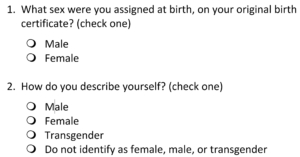
By Joe Hopper, Ph.D.
Related Posts

- Skip to main content
- Skip to primary sidebar
- Skip to footer
- QuestionPro

- Solutions Industries Gaming Automotive Sports and events Education Government Travel & Hospitality Financial Services Healthcare Cannabis Technology Use Case AskWhy Communities Audience Contactless surveys Mobile LivePolls Member Experience GDPR Positive People Science 360 Feedback Surveys
- Resources Blog eBooks Survey Templates Case Studies Training Help center
Home Surveys
Gender Survey Questions For Questionnaires

Understanding different genders’ unique viewpoints and experiences is critical for businesses, researchers, and organizations in the modern age. When conducting surveys or questionnaires, it is critical to include gender survey questions that are respectful, inclusive, and yield meaningful insights.
In this blog, we will discuss the significance of gender questionnaires and give you a strategy for creating inclusive and effective gender questionnaires.
Content Index
What is the gender survey question?
Importance of gender survey questions in a questionnaire, why is there a need for more than two gender options in a questionnaire, transgender is an important category now, best practices for asking gender questions in a questionnaire.
Gender survey questions are a questionnaire that is asked of a participant to understand what is the gender of the respondent.
Analysis of the survey responses and considering gender as a parameter will enable a researcher to evaluate how gender plays a role in the participant’s choices and help him deduce a pattern.
Gender questionnaire questions are used in various types of research, such as business, social science research, etc. A survey question is one of the various types of survey questions that are most commonly asked in surveys.
Previously, only male and female options used to appear in such questions. However, with so many policies coming into place and with people accepting their genders freely, there are many more options. Gender questionnaire questions are sensitive. However, these can enable the researcher to analyze their data more accurately in their questionnaires .
With the growing importance of gender equality, it is important to phrase these questions in such a way that they do not offend any participants and provide a sense of inclusiveness to all gender categories.
A good survey design means it will accomplish two things: accuracy and inclusiveness. A questionnaire has to be designed so that it can collect accurate data using the best practices for survey designs and be inclusive at the same time.
The questionnaire’s objective should be to make the participant feel that their opinion matters and will be valued as much as any other participant, without any biases.
LEARN ABOUT: Conformity Bias
The old method, where the gender questionnaire provided only two options, namely male and female, suggests that everyone falls under only these two categories, which is against the two things mentioned above.
It suggests discrimination against transgender and non-conforming respondents, and many times the results achieved will not be accurate as there was no option given to the respondent. However, using a five-category question or a multi-step approach for gender data allows the participant to choose from various categories and also has the freedom to write an open-ended response.
Such an option provides the researcher with much more accurate data and makes the respondent feel valued and respected. Furthermore, it will also increase the response rate for the questionnaire because the participant does not feel he is forced to answer certain questions, especially if they are private.
While conducting a survey, it doesn’t hurt to know your survey respondents a little more, like their age, sex, gender, etc. Questions based on gender have a precious impact on the results. It will enable you to derive results and study behavioral patterns according to gender and to make wise decisions for the purpose you are conducting your research.
Asking gender questions enables you to ensure that your sample is representative or to study the gender effects on your research. Thus, using the age-old methods of asking gender questions of two options, if not altered, will keep giving you statistical data, which is not accurate, skipping important variations of responses based on gender and limiting understanding of the research .
Today’s social science research , public issues regarding gender discrimination, the rising consciousness of gender equality, and the movements around the world elucidate that giving two options or categorizing humans into two categories is outdated and ethically wrong.
Furthermore, considering the purpose of the survey, the analyses can be much more accurate if the demographic questions can be segmented into more than two categories.
For example, A cosmetic brand wants to survey to gather feedback about one of their products to help them market their product appropriately, depending on the audience. The feedback from a male will be different than that of a female.
Furthermore, other categories, such as transgender, will also have a different opinion about the product and are also a considerable target audience for the cosmetic brand.
Hence, a survey including gender questions having multiple choice options will give the company much more accurate data and make it easier to segment its audience and carry out appropriate marketing strategies based on the gender of the participants.
Start creating your own online surveys!
Our online software is trusted by some of the biggest brands in the world, and we have a FREE plan. Sign up now. See plans & features.
In recent years, there has been an increase in the number of transgenders, and they accommodate a significant portion of the population now.
According to a 2016 study conducted in the United States, it was observed that 0.6% of all adults, or about 1.4 million people identify as transgender. So, on average, it is wise to expect that if a survey is sent to 500 participants, there will be at least 3 transgenders among them. Also, some states in the US have a higher density of transgender than 0.6%.
Furthermore, it has also been proven that transgender is not a trait you get once you are an adult, but it is a deeply held identity right from childhood. Hence, addressing transgender in gender questionnaire is vital to get accurate demographic information without offending the participants and also showcases non-discrimination.
Furthermore, multiple gender categories are evolving; hence, we can see many survey designers trying to implement these in their surveys. With so many options, it has become difficult for survey researchers to understand the need to collect valuable demographic data and balance it with appropriate gender choices.
Although, while wording the question, a researcher has to ensure not to offend the participant and be respectful.
Following is an example of the number of choices that can be given in a gender choice question:
- Young woman
- Agender (no gender identity)
- Androgynous (not one specific sex)
- Gender fluid (different genders at different times)
- Bigender (two gender identities)
- Demi girl (partly girl)
- Demiboy (partly boy)
- Non-binary (not male or female)
- Genderqueer (non-traditional gender distinction)
- Trigender (shifts in three genders)
- Intersex (physical, hormonal, or genetic features of male
- Rather not say
- Other (please specify)
Considering the long list of genders accepted in today’s world, it is difficult to understand which have to be included and which are not.
Although inclusivity of all options is vital, certainly, you cannot use the entire list, as surveys cannot be monotonous or exhaustive and should not take much time for the participant.
Moreover, you have a legal obligation to collect only the needed information.
With data collection compliances (GDPR) coming into place, there will be tighter regulations to handle sensitive personal information. To understand when, how, and why to use a gender question for a questionnaire, you need to ask the following questions to yourself before designing a survey .
- Is there a need to ask the question at all?
- Should I ask about orientation and gender identity?
- How do I word my question?
- Does asking the question provide any business value?
One major confusion many people face is understanding the distinction between sex, sexual orientation, and gender. A researcher has to make sure the three questions are addressed separately. The distinction between these three points is as follows:
This refers to the anatomical characteristic of a person. When asking these questions, you should use options such as Male, Female, and Intersex.
Gender identity refers to what the person feels he is in a psychological sense, regardless of what sex a person was assigned at birth.
Sexual orientation questions
This refers to emotional, physical, and sexual attraction to other people and does not fall under the gender question category but is affiliated with it. Words like gay/lesbian, bisexual/pansexual, and heterosexual can be used to discuss sexual preference. Please note it is advised not to use homosexual as it is frowned upon by most people.
There are many ways a gender identity question can be worded to suit specific needs. A couple of approaches can be used to ask current gender identity questions in a survey.
1st approach
If you find there is a need to ask a gender question, the following can be used.
- Others (Please specify)
- Other (Please specify)
- Not applicable
Using this approach enables a researcher to include transgender categories and also gives enough importance to mention any other gender identity.
Moreover, using a multi-step approach is much faster to complete for a participant than using a single-step approach. Furthermore, adding ‘rather not say’ gives the participant a feeling that this is voluntary and not a forced question, which can give a good response rate for the survey.
2nd approach
If needed, an open-ended question can be asked.
- Gender?_____________
You may need to conduct text analysis for such a question; however, it is all-inclusive and will allow the participant to choose their own identity.
Apart from the decision to choose the approach, there are a few points that a researcher should not forget while using gender questions in a questionnaire. The following points will help you create a good survey design .
- Make sure you can justify why you are asking the question.
- Take into account the privacy and comfort of your participant over anything else.
- Maintain data security.
- Maintain anonymity of personal data.
- Try and include open-ended questions to give enough freedom to explain who they are.
- All gender questions are optional.
Understanding and recognizing our varied cultures requires gender-related questions in questionnaires. We can better understand gender identity-related issues by conducting inclusive and comprehensive questionnaires. Remember to offer options for different identities and respect respondents’ wishes to withhold information.
QuestionPro is a popular online survey platform offering various features and tools for designing and delivering surveys, including the ability to add gender survey questionnaires. You may use QuestionPro to create surveys that target gender-related themes and collect vital data. Let’s work toward a world where gender identity is celebrated and accepted.
LEARN MORE SIGN UP FREE
Frequently Asking Questions
Woman, man, transgender, and non-binary are gender-category responses. Chromosomes, hormones, and secondary traits define sex. Male, female, and intersex are typical sex response options.
Gender questions in surveys may reveal gender tendencies. The survey is affected by these gender-related questions. Gender-specific surveys are sometimes done.
MORE LIKE THIS

SWOT Analysis: What It Is And How To Do It?
Sep 27, 2024
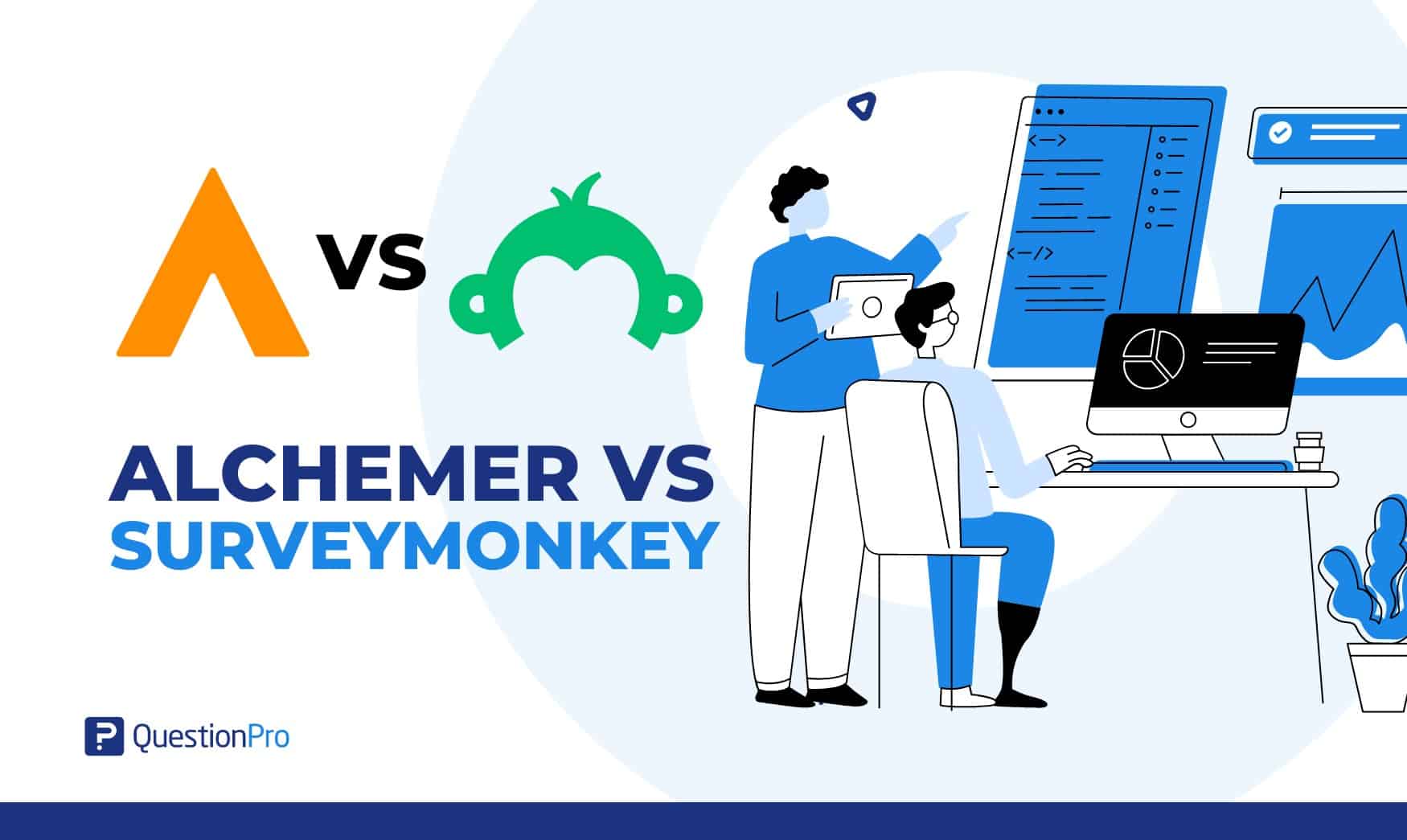
Alchemer vs SurveyMonkey: Which Survey Tool Is Best for You
Sep 26, 2024
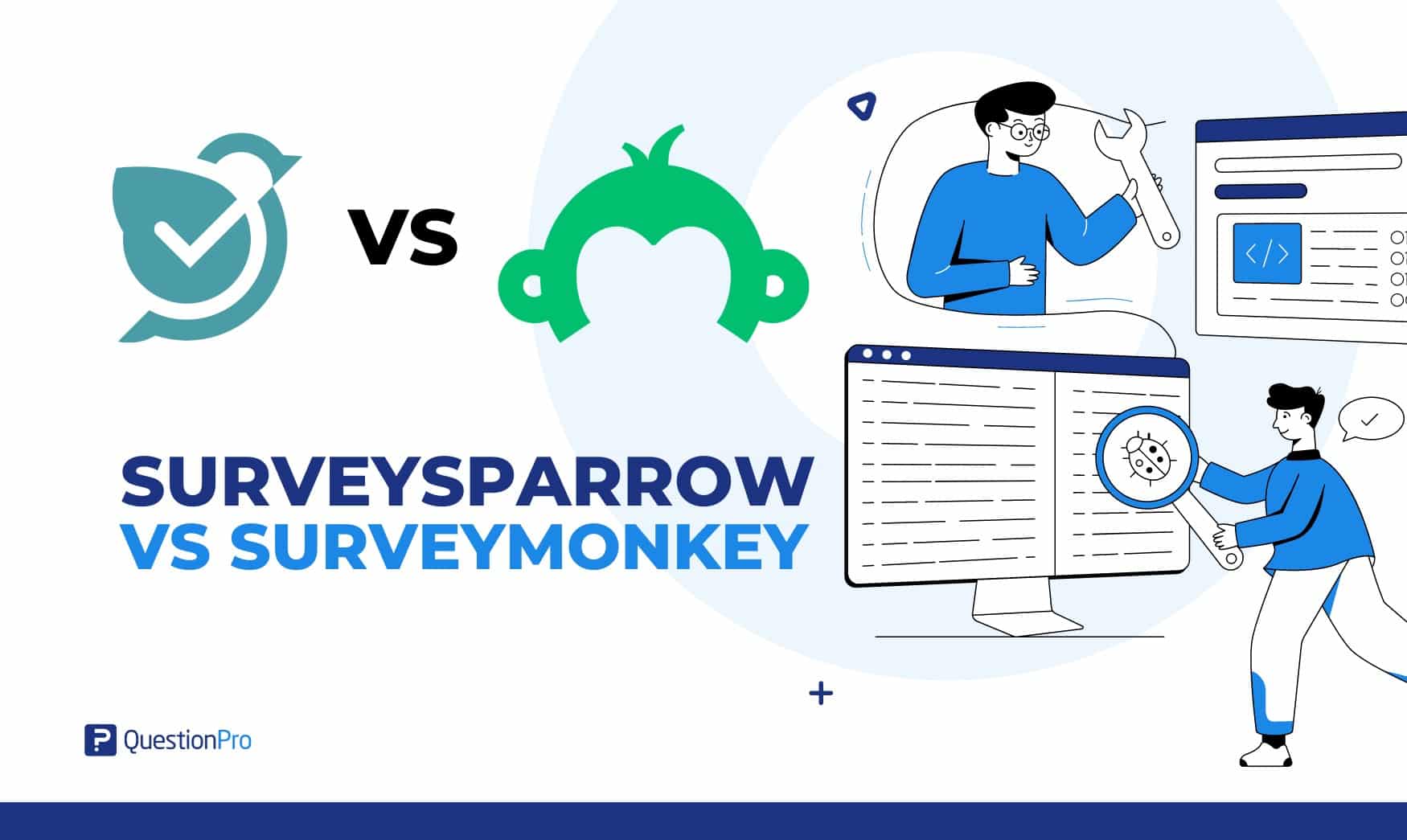
SurveySparrow vs SurveyMonkey: Choosing the Right Survey Tool
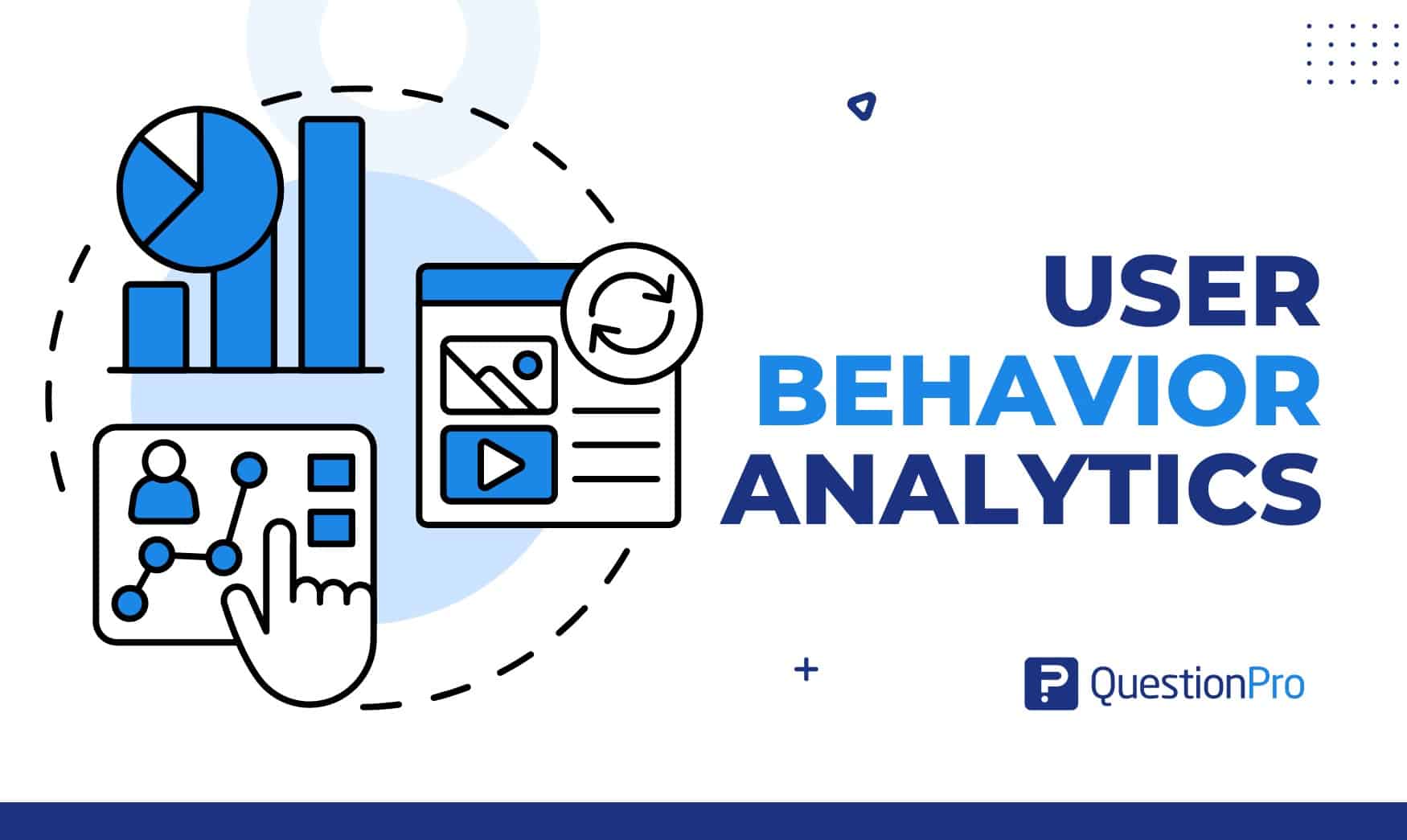
User Behavior Analytics: What it is, Importance, Uses & Tools
Other categories.
- Academic Research
- Artificial Intelligence
- Assessments
- Brand Awareness
- Case Studies
- Communities
- Consumer Insights
- Customer effort score
- Customer Engagement
- Customer Experience
- Customer Loyalty
- Customer Research
- Customer Satisfaction
- Employee Benefits
- Employee Engagement
- Employee Retention
- Friday Five
- General Data Protection Regulation
- Insights Hub
- Life@QuestionPro
- Market Research
- Mobile diaries
- Mobile Surveys
- New Features
- Online Communities
- Question Types
- Questionnaire
- QuestionPro Products
- Release Notes
- Research Tools and Apps
- Revenue at Risk
- Survey Templates
- Training Tips
- Tuesday CX Thoughts (TCXT)
- Uncategorized
- What’s Coming Up
- Workforce Intelligence

How to Write Gender Questions for a Survey
Gender and sexual orientation are intimate matters for each of us. However, in justified cases, such demographic questions are a part of studies and online surveys. Do you want to learn what, when, and how to ask sensitively about sex or gender identity? Here you will find all the tips concerning gender options on the survey.
Try one of the best demographic survey tools for free!
Start trial period without any credit card or subscription and easily gather impactful feedback via link, social media, email, and more.
Create first survey
No credit card required · Cancel any time · GDRP Compilant
What Are Demographic Questions?
Let’s start from the beginning. Questions about age, place of residence, or education level help us better understand the respondent’s needs. These are demographic questions. You must have come across them many times while completing the various questionnaires.
This group of survey questions also includes those about the gender or sexual orientation of the respondents. Ask yourself would you feel comfortable answering about your current gender identity? It depends on the context and the type of research, right? This type of question is sensitive, so we include them in the questionnaire only when necessary. Or when we are aware that they will not alienate respondents.
Demographic Questions for Survey
No matter what industry you operate in – a personalized, customer-tailored offer gives you a much better chance to stand out from the competition. That is why it is so important to conduct regular surveys that define the client’s socio-demographic profile.
If you want to know more, here’s a piece of writing you may find interesting: Types of Demographic Questions in a Survey . You will find in it more details about the types and examples of demographic research.
Now let’s focus on the specific type of demographic data – sex and gender questions.
Why And When to Ask Questions on Sexual Orientation?
Sexual orientation and gender are delicate topics. So why do we ask our survey respondents about these issues? Let me point out some of the reasons.
Sex and gender identity – brief definitions
Just to be on the same page, let us explain what gender identity refers to.
Gender identity may correlate to the individual’s sex assigned at birth (male, female – birth gender), or be different. Some people don’t identify with their biological sex. In most common situations, they describe themselves as transgender individuals or non-binary.
Non-binary (or genderqueer) is an umbrella term. It refers to a part of the population that doesn’t identify themselves as male or female.
Reasons for Asking Questions about Gender in a Survey
Not to offend your customers or users
Gender identity is not a temporary fashion or whim. It’s about a person’s emotional feelings and science. Therefore, you should address your customers or users as they wish. Why? To make them feel safe and comfortable.
The times when survey researchers asked just about biological sex providing their respondents with just two possible answers (male or female) are gone forever. Such questions nowadays require much more response options.
Again, it’s about human nature and the development of biological science. We know much more about ourselves these days. We can also, following gender identity, address specific people in a way that they do not feel disrespected or touched.
How to ask about gender without offending? We’ll come back to this one.
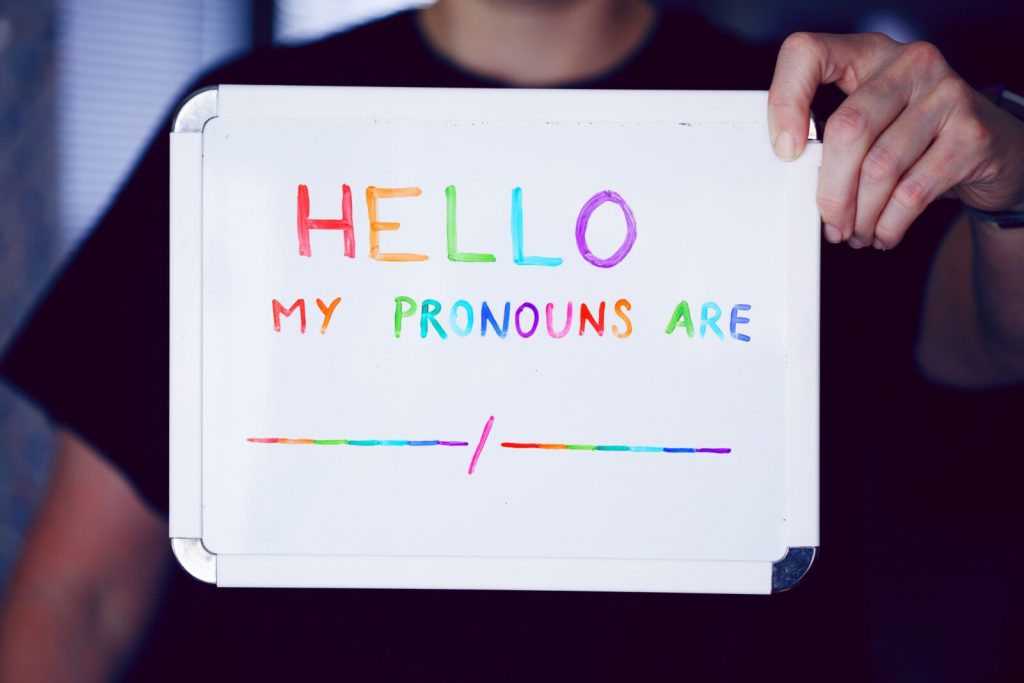
Take care of your respondents’ feelings.
For collecting demographic information purposes
If you’re into surveys, you want to collect meaningful and actionable insights. There’s nothing more irritating than gathering poor data or asking about wrong things. Keep in mind for your next relevant research project and future studies that 1.6 million Americans aged 13 and older identify as transgender (data by the Williams Institute).
Ignoring orientation and gender identity or leaving only two possible answers in a questionnaire (male and female) may distort the results of a demographic survey. It will make your research less relevant.
Don’t ignore trans respondents. Instead of a traditional approach, add a wider range of available options with more inclusive and open-ended responses.
To personalize your surveys & show support
The more you know about your respondents, the better and more impactful your forms are. With a few quick gender questions on a survey, you may adjust all your communication to your audience and make them comfortable while completing the questionnaire.
You may also want to show support to any discriminated representatives of our society. You don’t need to run a human rights campaign to show that trans people are as important to you as any others. After all, we are all the same, right?
For health and social purposes
Probably the vast majority of surveys that you receive are connected with e-commerce. Demographic feedback is important but not indispensable in such scenarios. However, there are some types of surveys that require precise data about gender. For good reasons.
Social, economic and health forms may collect a lot of important data with a little help from gender questions on a survey. Such insights may lead authorities to more targeted and smarter decisions concerning, for example, public health issues, or identifying health risk factors.
Get inspired by ready-to-use demographic survey example
Gender Identity Options in Survey
Enough theory.
It’s time to take a look at how to list gender on a survey. In this paragraph, we’ll show you the most common types of questions regarding sex and gender. We’ll also provide you with hints about creating such surveys and asking about gender without offending your respondents.
Best practices:
Before you start asking survey questions, always determine why you’re doing so.
It’s also good to explain how you are going to use the collected data. If you’re planning to issue a report, or publish your studies, inform your respondents about it. They may be interested in reading or sharing that type of content.
Every time you ask for sensitive data, provide a “prefer not to answer” option. Not every respondent would like to share such insights, no matter the circumstances.
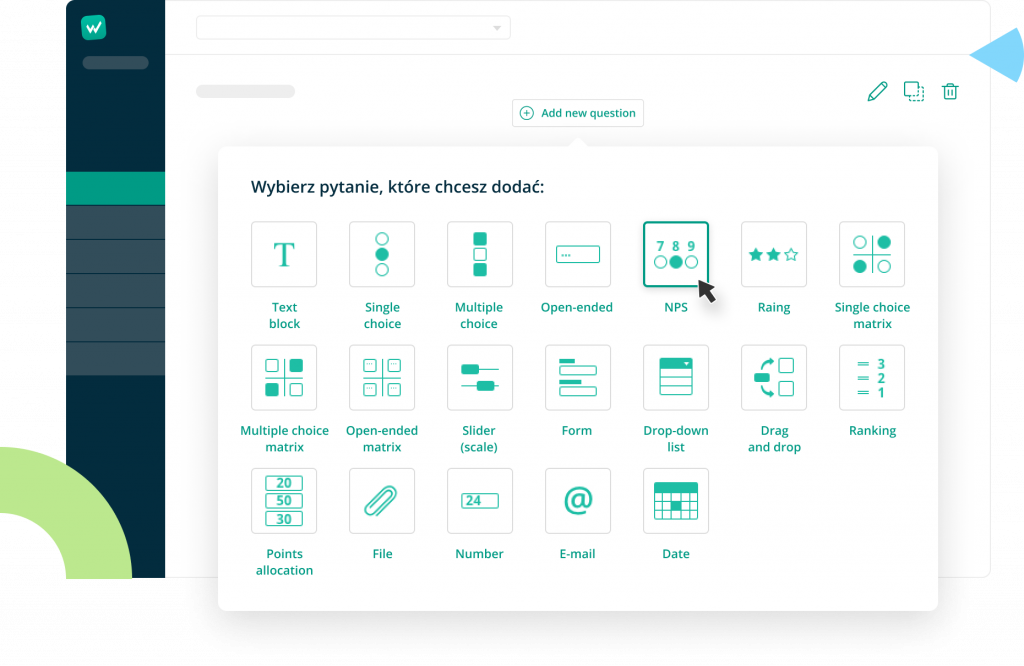
In Startquestion you will find a lot of question formats to choose from.
Let’s Talk About Sex
It’s an important piece of demographic information. And, probably, less sensitive to all kinds of gender survey questions. We’ve seen it for years in many questionnaires, starting from customer experience queries to medical forms.
The difference is, that you can’t provide respondents with just two options (male and female) anymore. You may list more options to choose from or decide on an open-ended question. With such a choice, respondents will type in their answers.
Sample Sex Questions
- Open-ended question
Could you please type in your sex?
- Question with answers to choose from
Sex: a) male; b) female; c) other [type]
Sexual Orientation
The rule is simple here. If you’re not 100 percent sure you need to ask about sexual attraction and preferences, don’t do it. It’s a private matter. Again, you may list a wide range of answers, or provide respondents with the possibility to answer in their own words.
It’s safe and assures you that you will not hurt anyone’s feelings concerning sexual identity.
Sample Sexual Orientation Questions
Could you please type in your sexual orientation?
Do you identify yourself as: a) heterosexual/straight; b) gay/lesbian; c) bisexual; d) other [type]; e) prefer not to answer.
- Questions regarding sexual attraction, or sexual behavior, such as:
Are you: a) attracted by women only; b) attracted by men only; c) attracted both by women and men; d) prefer not to answer; e) attracted by women mostly; f) attracted by men mostly; g) hard to say.
Asking about Gender Identity
Collecting demographic data with gender identity questions requires sensitiveness. Don’t limit provided responses just to sex assigned at birth (male, female). Add gender binary, and space to type in other identities.
Sample Gender Identity Questions
Could you please type in your gender?
Which gender identity do you identify with?
Possible answers: male, female, transgender, prefer not to answer, other [type].

Be sensitive while asking about sex orientation or gender identity.
Pros and Cons of Using the Gender Questions in Surveys
Collecting demographic information is not an easy task. Especially, when it touches on such sensitive topics as sexual orientation, gender identities, or sex assigned at birth.
Regardless of the effort and risk, it may be very beneficial. Here are some of the pros of asking gender-related questions to your respondents.
Emergency Contact Information Form
Use the ready survey to quickly collect contact in the event of an accident or emergency.
Advantages of asking gender identity survey questions
- Targeting – it’s hard to get trusted while asking about sensitive insights, but once you do so, you’ll be able to collect meaningful data.
- Branding – show that your company is aware of social issues. Treat transgender people with respect and act against any kind of discrimination in your brand communication.
- Improving your surveys – no matter what’s the survey topic, it’s always good to be sensitive, polite, and inclusive while asking for information.
Of course, there’s also the other side of the coin. Among the disadvantages of asking about sex or gender in a survey we may distinguish:
Disadvantages of asking gender identity survey questions
- Offending – no matter how hard you try, some of the respondents may find your questions impolite, or unnecessary.
- Inappropriate – some part of the general population is fed up with gender discussion. If they are among your customers or subscribers, you may lose them.
- Rejection – there’s always a risk of rejection or a high percentage of respondents that wouldn’t like to share with you about their sexual orientation or gender. Keep it in mind.
Ready to Ask the First Gender Question?
Start your free startquestion trial now.

Author: Dariusz Jaroń
Updated: 06 December 2022

How to Effectively Measure Service Quality
It’s not just about gathering data; it's about asking the right questions and using feedback to enhance customer satisfaction. Ready to take your service to the next level?

Omnichannel Experience Design
Welcome to the world of omnichannel retail, where seamless transitions between channels make the customer experience effortless, engaging, and personalized.

Receipt Survey: Customer Feedback at Your Fingertips
With Startquestion, collecting this data is effortless, and our specialists can help implement the receipt surveys in your company.
- Voxco Online
- Voxco Panel Management
- Voxco Panel Portal
- Voxco Audience
- Voxco Mobile Offline
- Voxco Dialer Cloud
- Voxco Dialer On-premise
- Voxco TCPA Connect
- Voxco Analytics
- Voxco Text & Sentiment Analysis

- 40+ question types
- Drag-and-drop interface
- Skip logic and branching
- Multi-lingual survey
- Text piping
- Question library
- CSS customization
- White-label surveys
- Customizable ‘Thank You’ page
- Customizable survey theme
- Reminder send-outs
- Survey rewards
- Social media
- Website surveys
- Correlation analysis
- Cross-tabulation analysis
- Trend analysis
- Real-time dashboard
- Customizable report
- Email address validation
- Recaptcha validation
- SSL security
Take a peek at our powerful survey features to design surveys that scale discoveries.
Download feature sheet.
- Hospitality
- Academic Research
- Customer Experience
- Employee Experience
- Product Experience
- Market Research
- Social Research
- Data Analysis
Explore Voxco
Need to map Voxco’s features & offerings? We can help!
Watch a Demo
Download Brochures
Get a Quote
- NPS Calculator
- CES Calculator
- A/B Testing Calculator
- Margin of Error Calculator
- Sample Size Calculator
- CX Strategy & Management Hub
- Market Research Hub
- Patient Experience Hub
- Employee Experience Hub
- NPS Knowledge Hub
- Market Research Guide
- Customer Experience Guide
- Survey Research Guides
- Survey Template Library
- Webinars and Events
- Feature Sheets
- Try a sample survey
- Professional Services

Get exclusive insights into research trends and best practices from top experts! Access Voxco’s ‘State of Research Report 2024 edition’ .
We’ve been avid users of the Voxco platform now for over 20 years. It gives us the flexibility to routinely enhance our survey toolkit and provides our clients with a more robust dataset and story to tell their clients.
VP Innovation & Strategic Partnerships, The Logit Group
- Client Stories
- Voxco Reviews
- Why Voxco Research?
- Careers at Voxco
- Vulnerabilities and Ethical Hacking
Explore Regional Offices
- Survey Software The world’s leading omnichannel survey software
- Online Survey Tools Create sophisticated surveys with ease.
- Mobile Offline Conduct efficient field surveys.
- Text Analysis
- Close The Loop
- Automated Translations
- NPS Dashboard
- CATI Manage high volume phone surveys efficiently
- Cloud/On-premise Dialer TCPA compliant Cloud on-premise dialer
- IVR Survey Software Boost productivity with automated call workflows.
- Analytics Analyze survey data with visual dashboards
- Panel Manager Nurture a loyal community of respondents.
- Survey Portal Best-in-class user friendly survey portal.
- Voxco Audience Conduct targeted sample research in hours.
- Predictive Analytics
- Customer 360
- Customer Loyalty
- Fraud & Risk Management
- AI/ML Enablement Services
- Credit Underwriting

Find the best survey software for you! (Along with a checklist to compare platforms)
Get Buyer’s Guide
- 100+ question types
- SMS surveys
- Financial Services
- Banking & Financial Services
- Retail Solution
- Risk Management
- Customer Lifecycle Solutions
- Net Promoter Score
- Customer Behaviour Analytics
- Customer Segmentation
- Data Unification
Explore Voxco
Watch a Demo
Download Brochures
- CX Strategy & Management Hub
- The Voxco Guide to Customer Experience
- Professional services
- Blogs & White papers
- Case Studies
Find the best customer experience platform
Uncover customer pain points, analyze feedback and run successful CX programs with the best CX platform for your team.
Get the Guide Now

VP Innovation & Strategic Partnerships, The Logit Group
- Why Voxco Intelligence?
- Our clients
- Client stories
- Featuresheets

Crafting Inclusive Gender Survey Questions
SHARE THE ARTICLE ON
A survey questionnaire is one of the ways that enables you to connect to a larger audience. At times, making use of survey questions based on demography is required to fully comprehend the data as it adds to the depth of your research. In a demographic survey, gender and age are two of the most often requested questions.
Survey questions revolving around gender could be sensitive because people no more fit into the preconceived gender stereotypes. Gone are those days where surveys could be conducted by selecting one of the two basic binary gender options. It has become extremely important to be more gender-inclusive these days, whilst being mindful of not hurting anyone.
Transform your insight generation process
Create an actionable feedback collection process.

What are Gender Survey Questions?
Gender survey questions are often asked to determine the gender of a person. Gender survey questions could be a part of various kinds of surveys, including market research.
Knowing the gender of the respondents could serve as a parameter and help surveys understand how gender influences the choices of an individual.
When asking gender-specific questions, it is important to frame the questions such that they do not come across as offensive while simultaneously creating a sense of belonging to people of all genders. Understanding the context in which these questions are being asked will help to create a more thoughtful survey.
Let us walk through a few terms to consider before designing gender questions in a survey.
- Sex – The biological attributes of an individual are referred to as sex. It is the identity assigned at the time of birth based on the chromosomes and other medical factors.
- Gender – Gender refers to an individual’s perception of themselves as male, female, or of a different gender. Gender identity refers to how a person identifies themselves, irrespective of the sex assigned to them at birth.
- Transgender – It is an umbrella term that is used to describe people who do not identify with the gender assigned to them at birth.
Importance of Gender Questions in a survey
The purpose of a survey is to let people know that they are heard and their opinion is valued. Surveys can provide more valuable data if the questions are asked consciously. Asking gender questions in a survey could provide an insight into patterns among different gender categories. These questions help to determine how gender impacts the choices of an individual, thereby having an impact on the survey.
At times, surveys are conducted for specific gender categories. Knowing the gender identity allows you to screen out participants in the beginning itself.
Let us take an example here,
Consider a clothing brand running a survey to improve its marketing strategies by collecting feedback from the customers. Here, a male customer will have different feedback than a female customer. Similarly, other gender categories such as transgender will also have an opinion. The survey will be able to draw conclusions concerning specific categories of gender and marketers will be able to tailor marketing strategies to those segments.
Gender surveys conducted in organizations could help them tailor their policies to provide a sense of inclusivity to people of all genders. Organizations can create an environment that encourages diversity, giving them an edge over their competitors.
Download Market Research Toolkit
Get market research trends guide, Online Surveys guide, Agile Market Research Guide & 5 Market research Template

How to ask the Gender Question?
Often, questions are asked because they are considered as typical demographic questions, rather than because the data are of utmost importance.
If gender is an important aspect of the survey and contributes to your research, offer questions in a way that respondents will feel a sense of belonging.
Understand why you’re asking the question
The first and foremost factor to consider is the reason behind conducting the survey. A few questions that could help are:
- How will the information collected be used?
- What measures will be taken to protect the data?
- Are there restrictions on the collection of demographic data? If yes, do thorough research.
Consider keeping the question as an optional one
Allow the respondent to choose whether or not to answer the question. There could be a “prefer not to answer” option so that they can opt-out of the question.
Keep the options more gender-inclusive
The response options to a gender question in a survey should not be limited to male or female. The answer choices that can be given in a gender question are listed below:
- Gender fluid
- Androgynous
Avoid giving too many gender options
While we emphasize the significance of gender diversity, we also don’t want to overwhelm responders with too many options. Gender categories are evolving, which could make it difficult to determine which ones should be included. Using the complete list in surveys is certainly not an option.
We’ve listed below two types of gender questions that could be used in your surveys.
See Voxco survey software in action with a Free demo.
Types of Gender Questions to use in Surveys
Close ended questions.
A close-ended question usually provides the respondents with several response options to choose from. One of the most prevalent types of closed-ended questions is a multiple-choice question.
A close-ended question could be framed as follows:
What gender do you identify as?
- Transgender
- Prefer not to answer
The above question sounds more inclusive, giving the respondents a choice to not answer the question.
Open-Ended Questions
Open-ended questions do not restrict the participants to a set of prepared responses. They allow the respondents to be more expressive by giving them an option to provide lengthy answers. These types of questions can be used to understand an individuals’ feelings.
Here’s an example of an open-ended question,
Gender ——–
Finally, keep in mind that when framing gender questions for surveys, it is vital to choose your words thoughtfully so that respondents will feel comfortable and safe sharing their thoughts.
Explore all the survey question types possible on Voxco
Explore Voxco Survey Software
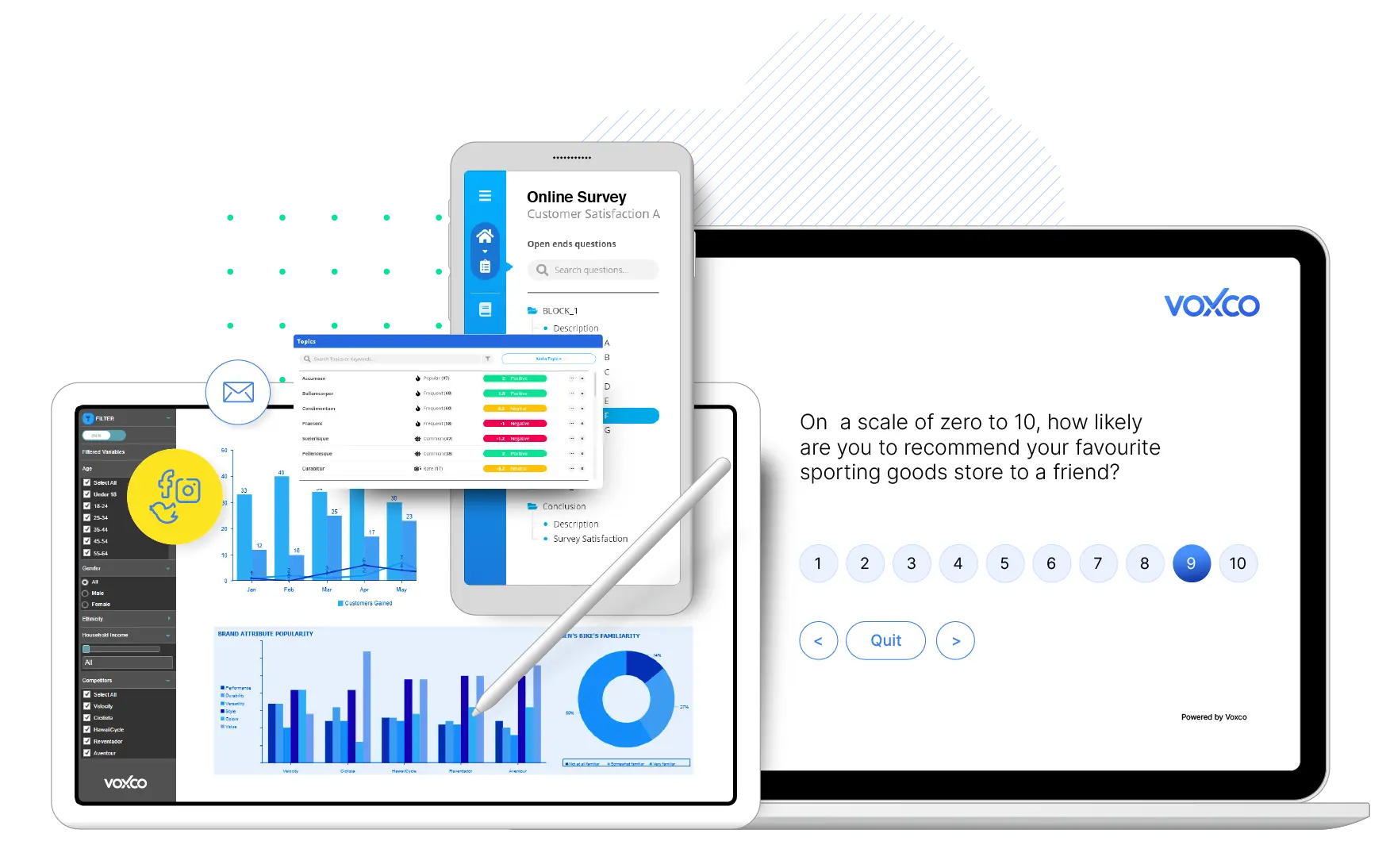
+ Omnichannel Survey Software
+ Online Survey Software
+ CATI Survey Software
+ IVR Survey Software
+ Market Research Tool
+ Customer Experience Tool
+ Product Experience Software
+ Enterprise Survey Software
We use cookies in our website to give you the best browsing experience and to tailor advertising. By continuing to use our website, you give us consent to the use of cookies. Read More
| Name | Domain | Purpose | Expiry | Type |
|---|---|---|---|---|
| hubspotutk | www.voxco.com | HubSpot functional cookie. | 1 year | HTTP |
| lhc_dir_locale | amplifyreach.com | --- | 52 years | --- |
| lhc_dirclass | amplifyreach.com | --- | 52 years | --- |
| Name | Domain | Purpose | Expiry | Type |
|---|---|---|---|---|
| _fbp | www.voxco.com | Facebook Pixel advertising first-party cookie | 3 months | HTTP |
| __hstc | www.voxco.com | Hubspot marketing platform cookie. | 1 year | HTTP |
| __hssrc | www.voxco.com | Hubspot marketing platform cookie. | 52 years | HTTP |
| __hssc | www.voxco.com | Hubspot marketing platform cookie. | Session | HTTP |
| Name | Domain | Purpose | Expiry | Type |
|---|---|---|---|---|
| _gid | www.voxco.com | Google Universal Analytics short-time unique user tracking identifier. | 1 days | HTTP |
| MUID | bing.com | Microsoft User Identifier tracking cookie used by Bing Ads. | 1 year | HTTP |
| MR | bat.bing.com | Microsoft User Identifier tracking cookie used by Bing Ads. | 7 days | HTTP |
| IDE | doubleclick.net | Google advertising cookie used for user tracking and ad targeting purposes. | 2 years | HTTP |
| _vwo_uuid_v2 | www.voxco.com | Generic Visual Website Optimizer (VWO) user tracking cookie. | 1 year | HTTP |
| _vis_opt_s | www.voxco.com | Generic Visual Website Optimizer (VWO) user tracking cookie that detects if the user is new or returning to a particular campaign. | 3 months | HTTP |
| _vis_opt_test_cookie | www.voxco.com | A session (temporary) cookie used by Generic Visual Website Optimizer (VWO) to detect if the cookies are enabled on the browser of the user or not. | 52 years | HTTP |
| _ga | www.voxco.com | Google Universal Analytics long-time unique user tracking identifier. | 2 years | HTTP |
| _uetsid | www.voxco.com | Microsoft Bing Ads Universal Event Tracking (UET) tracking cookie. | 1 days | HTTP |
| vuid | vimeo.com | Vimeo tracking cookie | 2 years | HTTP |
| Name | Domain | Purpose | Expiry | Type |
|---|---|---|---|---|
| __cf_bm | hubspot.com | Generic CloudFlare functional cookie. | Session | HTTP |
| Name | Domain | Purpose | Expiry | Type |
|---|---|---|---|---|
| _gcl_au | www.voxco.com | --- | 3 months | --- |
| _gat_gtag_UA_3262734_1 | www.voxco.com | --- | Session | --- |
| _clck | www.voxco.com | --- | 1 year | --- |
| _ga_HNFQQ528PZ | www.voxco.com | --- | 2 years | --- |
| _clsk | www.voxco.com | --- | 1 days | --- |
| visitor_id18452 | pardot.com | --- | 10 years | --- |
| visitor_id18452-hash | pardot.com | --- | 10 years | --- |
| lpv18452 | pi.pardot.com | --- | Session | --- |
| lhc_per | www.voxco.com | --- | 6 months | --- |
| _uetvid | www.voxco.com | --- | 1 year | --- |

Gender Questions
Student plan discount, discount request form.
When it comes to survey questions, there are some questions that can prove rather sensitive, particularly those based on demographics, which are typically used to gather essential background information about a survey participant.
Questions around gender are a good example of this. Gender is quite a complex topic, given the many facets to how people view themselves, which can lead into discussions around ‘sexuality’, ‘sexual orientation’ and ‘gender identity’.
What are demographics?
Essentially demographic questions are those that look to better understand the identity of a particular respondent, by identifying which groups they fit into within the general population.
They aim to achieve this by categorising the answers of individuals to a series of demographic questions, based on factors ranging from age, ethnicity and gender, to education, marital status, employment and location.
Gender options for a survey
People can often feel uncomfortable about asking questions about a person’s gender or sexuality in a survey, worried that if they say the wrong thing or use the incorrect term, they could easily offend someone.
However, that doesn’t mean you should steer clear of these questions. Instead, you should know why you’re asking them and how you’ll be using the data, as clarity around this will help ensure you create better, more intentional questions.
For example, the office for National Statistics (ONS) , recently explained why they were looking at collecting information on gender identity , in addition to their existing question on sex, in order to better support work on policy development, service provision and to further equality.
Collecting this information can also be beneficial for employers of all shapes and sizes, as the data can allow them to measure how successful they have been in promoting inclusion, or what more they need to do to improve their work in this area.
However, before examining any of the issues around gender in a survey, it’s important to be reasonably familiar with them first. Here’s some of the key terms explained, as defined by the Council of Europe.
Sex refers to the biological and physiological characteristics that differentiate men and women. Being defined as male or female, happens at birth and becomes a social and legal fact from that point on.
Gender identity:
Our gender identity refers to the gender to which we feel we belong, which may or may not be the same as the sex that was assigned to us at birth. It refers to each person’s deeply felt internal and individual experience of gender including the personal sense of our body and other expressions, such as dress, speech and mannerisms.
Sexual orientation:
Refers to a person’s emotional and sexual attraction to males, females, both or neither. Sexual orientation is not linked to gender identity. For example, a transgender man may be heterosexual or gay in the same way that another man may be heterosexual or gay. However, these two aspects of identity are often linked by people and affect how lesbian, gay, bisexual and transgender (LGBT) individuals are treated and perceived.
Transgender:
Is an umbrella term used to describe people who have a gender identity, which is different from the gender that was assigned to them at birth and wish to portray their gender identity in a way that is different from their gender at birth.
Given the differences in the terms discussed, think about which ones you need to ask and the best way to ask them, depending on your survey needs. For example, if you work in healthcare and were doing a patient feedback survey about a medical service you had been providing you might want to use the term ‘sex’, as opposed to word ‘gender’ which might be more appropriate for another more generic survey, such as a customer satisfaction survey.
How to ask the gender question
Whatever gender options you have considered and then decided on using in your survey, you still need to ask these questions in the right way, if you’re to gain the most value from their use.
First and foremost, you need to ensure that any survey questions on gender or sexuality are carefully worded. If the wording is unclear, you could confuse people and your data will be less meaningful. Worse still, if your wording is inappropriate, you could cause offense.
Think about including an opt-out
Questions around sexual orientation and gender identity (SOGI) can be very personal. So, you should always offer respondents the option not to answer anything they feel uncomfortable with. The phrase “Prefer not to say” is a good example of how you could word this.
Offer non-binary options
In today’s society where there are more than two accepted gender roles, it’s no longer inclusive to only provide two options “female” and “male” for people to identify with, as this can cause offense to those who feel they don’t fall into either category. It’s better to give them more options, including an open ‘other’ text field if they want to define their gender in their own words, otherwise known as ‘self-identifying’.
A good example is as follows.
What gender do you identify as?
[ ] Trans-gender
[ ] Non-binary
[ ] Prefer not to answer
[ ] Other________
Alternatively, you may prefer a more simplified version such as:
[ ] Or do you describe yourself in another way (write in gender identity)
Keep questions about gender identity and sexual orientation separate
Sometimes organisations combine gender identity and sexual orientation into one question. However, as they are two distinct elements of a person’s identity, you would be better off keeping them separate.
Although sexual orientation questions are typically not used as much as gender identity questions in surveys and questionnaires, their use is more commonplace in some government and public sector surveys, to monitor the equality of groups of people with different sexual orientation. And when the question is included, it’s usually presented as voluntary.
A good example is as follows:
Which of the following best describes your sexual orientation? (Note: This question is voluntary)
[ ] Straight/Heterosexual
[ ] Gay or Lesbian
[ ] Bisexual
[ ] Other sexual orientation (write in)
Pros and cons of using the gender question
While we’ve provided a good overview of gender questions, some of its key terms and how to go about asking questions around this topic, it can also be useful to know about some of the potential benefits and drawbacks to asking the gender question, to help ensure you use it in the best way.
The Benefits
Screen out those who are not relevant to your survey:.
Depending on the type of survey you’re carrying out and the topic of your content, knowing the gender identity of your respondent, particularly early on could be extremely valuable.
For example, if you were a manufacturer of female healthcare products you could use a gender based demographic question at the start of your survey, to screen out male respondents and ensure only female respondents could move on and complete your survey.
Maximise the targeting and effectiveness of your marketing efforts:
Continuing with the above example, with irrelevant respondents removed from participating in your survey, it could strengthen the targeting and effectiveness of your marketing efforts, knowing that the audience that remains are likely to be the most interested in answering and completing your survey.
Build stronger surveys
Gender issues and the gender question are all part of the wider debate around inclusivity. And inclusive surveys are all about being conscious and careful about how you ask questions about gender and other sensitive issues that can include anything from ethnicity and religion to household income and age.
From the language you use to taking account of accessibility issues. When you’re able to better consider your respondents’ experience from many perspectives and prioritise inclusion, it can be hugely beneficial to your survey’s impact, paving the way for richer and more valuable data.
Make your organisation appear more inclusive and a more attractive place to work
These days organisations that can claim to promote diversity, equality and fair treatment are seen to be at an advantage over their competitors in terms of their overall performance, with the collection and analysis of demographic data essential to this process.
However, you still need to be able to present and ask these questions in the right way. If you’re able to achieve that, your standing among the wider population as an inclusive and attractive place to work will only continue to get better.
The Limitations
While there are some definite advantages to asking the gender question, there can be some drawbacks too. However, you’re more likely to experience them if you didn’t frame your questions up correctly in the first place.
You could risk offending someone
As we have already discussed, if you don’t give respondents sufficient options to describe their gender identity, or even the opportunity to opt out of answering this question altogether, you could risk offending someone. You can then run the risk of them telling others about their experience, which could negatively affect other peoples’ perception of your organisation.
You could miss out on valuable survey data and insight
Ultimately, when you send out your survey, you want as many people as possible to complete it, to help maximise your response rate and the quality of data you have to work with. Subsequently, if your gender question is poorly constructed, it could result in many people choosing not to participate in your survey.
If that happened, you could potentially lose out on valuable data and insights, which could be particularly damaging if you were running a small, niche survey, that was reliant on having as many completed responses as possible.
Your data could be less representative
Gender related demographic questions in surveys can now be viewed as biased if they fail to capture other gender orientations in a population. And if you don’t correct this imbalance within your own survey questions, you could be left with data that’s not truly representative of the groups that you’ve tried to reach out to.
Further reading
Age groups for surveys : How to ask for respondents’ age in your survey.
Common types of survey question : Other question types to use in your next survey.
Working Women : An example of a research project based around gender, on the best places for women to work and live.
More survey design advice
Book your demo today, how are we different.

Your data will be stored and processed here in the UK for your peace of mind.
Fanatical support
We pride ourselves on going above and beyond for our customers, providing expert advice and support whenever you need it.
You're in safe hands
Our secure platform and robust data protection measures ensure your data is safe and secure with us. We are ISO27001 and Cyber Essentials Plus certified.
We're human
We understand the importance of personal interaction, which is why we offer a human touch alongside our cutting-edge technology.
Accessibility matters
We're committed to making our surveys accessible to everyone, with a range of features to support those with disabilities.
Unlimited responses
With no limits on the number of responses you can collect, you can be sure your survey will reach as many people as possible without it being cost prohibitive.

Don’t just take our word for it

It wasn’t a hard choice to select SmartSurvey. Not only did they understand what we were looking to achieve right from the start, they presented a solution that represented everything we needed.

We couldn't be happier with SmartSurvey, we love its functionality and flexibility. This means we have been able to use one survey tool across many parts of the business.

Get in touch
We are ISO27001 certified, registered under the Data Protection Act and fully compliant with EU Privacy Laws.
Access to a knowledgeable account manager for personal assistance for when you most need it.
Our friendly design team is on hand to assist with any bespoke design and custom development requests.
We succeed if you succeed. Our goal is to help you carry out effective research and we’re here to help you achieve that.
Find out how we can help
Get started and create your first survey, elevate your survey game. discover the power of our cutting-edge survey software with a personalised demo, survey uses, survey distribution, survey templates, comparisons, useful links.
- Contributors
- Links
- Translations
- What is Gendered Innovations ?
Sex & Gender Analysis
- Research Priorities
- Rethinking Concepts
- Research Questions
- Analyzing Sex
- Analyzing Gender
- Sex and Gender Interact
- Intersectional Approaches
- Engineering Innovation
- Participatory Research
- Reference Models
- Language & Visualizations
- Tissues & Cells
- Lab Animal Research
- Sex in Biomedicine
- Gender in Health & Biomedicine
- Evolutionary Biology
- Machine Learning
- Social Robotics
- Hermaphroditic Species
- Impact Assessment
- Norm-Critical Innovation
- Intersectionality
- Race and Ethnicity
- Age and Sex in Drug Development
- Engineering
- Health & Medicine
- SABV in Biomedicine
- Tissues & Cells
- Urban Planning & Design
Case Studies
- Animal Research
- Animal Research 2
- Computer Science Curriculum
- Genetics of Sex Determination
- Chronic Pain
- Colorectal Cancer
- De-Gendering the Knee
- Dietary Assessment Method
- Heart Disease in Diverse Populations
- Medical Technology
- Nanomedicine
- Nanotechnology-Based Screening for HPV
- Nutrigenomics
- Osteoporosis Research in Men
- Prescription Drugs
- Systems Biology
- Assistive Technologies for the Elderly
- Domestic Robots
- Extended Virtual Reality
- Facial Recognition
- Gendering Social Robots
- Haptic Technology
- HIV Microbicides
- Inclusive Crash Test Dummies
- Human Thorax Model
- Machine Translation
- Making Machines Talk
- Video Games
- Virtual Assistants and Chatbots
- Agriculture
- Climate Change
- Environmental Chemicals
- Housing and Neighborhood Design
- Marine Science
- Menstrual Cups
- Population and Climate Change
- Quality Urban Spaces
- Smart Energy Solutions
- Smart Mobility
- Sustainable Fashion
- Waste Management
- Water Infrastructure
- Intersectional Design
- Major Granting Agencies
- Peer-Reviewed Journals
- Universities
Formulating Research Questions
Research questions typically flow from research priorities (see Rethinking Research Priorities and Outcomes ) and from the theories and concepts that frame research (see Rethinking Concepts and Theories ). Research priorities—along with concepts and theories—directly influence how research is designed. They function to
- 1. delimit questions asked—and, by implication, questions not asked (see, for example, Case Study: Genetics of Sex Determination ).
- 2. frame the research design and choice of methods.
As with other stages of the research and development processes, the choice of a research question is often underpinned by assumptions—both implicit and explicit—about sex and gender (see Method: Analyzing Gender ). As in other stages of research and development, potential for creative innovation lies in critically examining existing practices in light of available evidence about sex and gender (Bührer et al., 2006; Schraudner et al., 2006; Schiebinger, 2008; Wylie, et al., Klinge, 2010; IOM, 2010; Wajcman, 2010).
Critical questions for analyzing the significance (if any) of sex and gender in formulating research questions:
1. What is the current state of knowledge of sex and gender ( norms , identities , or relations ) in a given area of research or development?
2. What do we not know as a result of not analyzing sex and gender?
3. How have sex and gender functioned to limit the research questions posed in this field? For example, coronary angiography is a powerful diagnostic tool for assessing coronary artery disease, but it can cause bleeding complications, especially in women. Researchers asked how angiography could be made safer and designed and patented new catheters and procedures to allow angiography from the radial artery rather than the groin. This shift reduces bleeding in everyone (see Case Study: Heart Disease in Diverse Populations ).
4. Have assumptions been made about sex and gender? Are these justified in light of available evidence? Are assumptions underpinning these research questions invalid when subjected to critical analysis? For example, cultural assumptions about gender difference can lead companies to market “gender-specific” products—in one case a sex-specific knee prosthesis—that may not be the best choice for consumers (see Case Study: De-Gendering the Knee ). Have researchers assumed a sex or gender binary? For example, recent research suggests that some transgender people may be at higher risk for heart disease, but transgender patients are not typically a focus for heart disease research (see Case Study: Heart Disease in Diverse Populations ).
5. Have any potentially relevant groups of research subjects been left out (e.g., female animals in drug research, women and gender-diverse people in systems biology, pregnant women and large people in automotive engineering)? (See Case Studies: Prescription Drugs , Systems Biology , and Inclusive Crash Test Dummies .)
6. What research questions would lead to more robust research designs and methods? For example, in studies of sexual differentiation, geneticists have revealed the shortcomings of scientific models that portrayed the female developmental pathway as “passive.” By challenging assumptions of passivity, researchers formulated new questions about the ovarian developmental pathway. New findings now suggest that both female and male development are active, gene-mediated processes (see Case Study: Genetics of Sex Determination ).
Related Case Studies
Works cited.
Bührer, S., Gruber, E., Hüsing, B., Kimpeler, S., Rainfurth, C., Schlomann, B., Schraudner, M., & Wehking, S. (2006). Wie Können Gender-Aspekte in Forschungsvorhaben Erkannt und Bewertet Werden? München: Fraunhofer.
Klinge, I., & Wiesemann, C. (Eds.) (2010). Sex and Gender in Biomedicine: Theories, Methodologies, and Results . Göttingen: Universitätsverlag.
Institute of Medicine (IOM). (2010). Women’s Health Research: Progress, Pitfalls, and Promise . Washington, D.C.: United States National Academies Press.
Schiebinger, L. (Ed.) (2014). Women and Gender in Science and Technology, 4 vols. London: Routledge.
Schraudner, M., & Lukoschat, H. (Eds.) (2006). Gender als Innovationspotenzial in Forschung and Entwicklung . Karlsruhe: Fraunhofer Institut.
Wajcman, J. (2010). Feminist Theories of Technology. Cambridge Journal of Economics, 34 (1), 143-152 .
Wylie, A., & Conkey, M. (2007). Doing Archaeology as a Feminist. Journal of Archaeological Method and Theory, 14 (3) , 209-216.
- Advanced Scripting
- Online Diaries
- Facial Coding & Neuroscience
- Online Communities
- Online Qualitative Recruitments
- Digital Behavior
- Geolocation
- Audio-matching
- In-Home Usage Testing [IHUT]
- Mystery Shopper
- Ad Tracking Cookies
- Knowledge base

How to Design a Market Research Questionnaire?
Table of contents.
How to Design a Market Research Questionnaire
Importance of the Questionnaire in a Market Study
Key Elements of a Market Research Questionnaire
Methodology for Designing Effective Market Research Questions
Differences between qualitative and quantitative questions in market research, recommended structure for a market research questionnaire.
The market research questionnaire is an essential tool for gathering valuable information about consumers, their preferences, behaviors, and needs. The quality of the data you obtain will largely depend on how you structure and formulate the questions. A well-crafted questionnaire can make a big difference in business decision-making, helping to identify opportunities and adjust strategies. Below, we explain how to design an effective questionnaire and what types of questions can provide precise and useful results for your market study.
The success of a market study largely depends on the quality of the questionnaire. This tool allows for the direct collection of data from participants, helping you understand firsthand the opinions and perceptions of the target audience. Without a well-constructed questionnaire, you risk obtaining incomplete or biased information, which can negatively affect the reliability of your conclusions.
Additionally, the market research questionnaire is essential at any stage of product or service development. From the initial exploration of ideas to evaluating customer satisfaction, a well-designed questionnaire provides actionable data that enables businesses to adjust their strategies and maximize success.

Key Elements of a Market Research Questionnaire
To ensure that your questionnaire achieves its purpose, it is important to consider some essential elements:
- Clarity in the questions : Avoid ambiguous or confusing questions. Respondents must clearly understand what is being asked of them.
- Appropriate length : A questionnaire that is too long can discourage participants. Strike a balance between gathering sufficient information and not exhausting the patience of the respondents.
- Objectivity : Questions should be phrased neutrally to avoid influencing participants' responses.

Designing questions for a market study requires a structured and meticulous approach. Here are some steps to follow:
- Define the study’s objectives : Before drafting any questions, it is crucial to be clear about what information you want to obtain.
- Group questions by topic : This helps with the flow of the questionnaire and makes the questions seem more natural.
- Choose the type of questions : They can be open-ended (for detailed responses) or closed (for specific, easy-to-analyze answers).
Examples of Market Research Questions
Open-ended questions : “What aspects would you improve in our product?” These questions allow for detailed responses that can provide valuable insights.
Closed-ended questions : “How often do you buy this product?” (Options: weekly, monthly, never) These are easy to answer and analyze, ideal for gathering quantitative data.
Questions in a market study are generally divided into two types:
- Qualitative questions : These aim to explore consumers' perceptions, opinions, and experiences. They are useful for understanding the "why" behind consumer actions.
- Quantitative questions : These seek measurable data, such as how frequently a product is used or satisfaction on a scale of 1 to 10. They are easy to analyze and compare.
A good structure for a market research questionnaire should include:
- Introduction : Briefly explain the purpose of the study and thank the participant for their time.
- General questions : Start with broader questions to make respondents feel comfortable.
- Specific questions : Then, address the key topics of your research.
- Conclusion : End with a section that allows the respondent to share any additional comments.
Essential Demographic Questions for a Market Study
Demographic questions help segment participants and understand how factors such as age, gender, or income level influence their responses. Some basic questions include:
- Educational level
- Household income
- Geographic location
Key Indicators for Evaluating the Quality of Market Study Questions
A good questionnaire is not just about asking the right questions but ensuring that the answers are useful. Here are some indicators to consider:
- Response rate : How many people completed the questionnaire?
- Clarity of responses : Do the answers provide the necessary information?
- Relevance : Are the questions pertinent to the study's objectives?
Advanced Techniques to Improve Response Rate in Market Research Questionnaires
- Incentives : Offering rewards can significantly increase participation rates.
- Short questionnaires : The shorter and more direct, the higher the likelihood of obtaining complete responses.
- Precise segmentation : Sending the questionnaire only to the most relevant participants improves both the quality of responses and the response rate.

Related Topics:
- How to Conduct a Survey: 10-Step Guide
- Questionnaire and Survey: How Do They Differ?
- What is a Sampling Survey and How to Use it in Research?
- What is a survey?
- Maximizing Data Accuracy: Validation and Reliability of Surveys
- Surveys for Youth: How to Approach Research?

Bachelor's degree in Communication Sciences from UNAM with studies in advertising, digital marketing, and market research. Coffee and animal lover with a keen interest in data analysis and content creation. Always seeking new challenges and learning opportunities.

DIY Tools: What advantages do they bring...
We’ve been too long on the Internet to deny that the DIY (Do It Yourself) tendency is more than a passing trend or fashion, it is a statement that ...

Maximizing Data Accuracy: Validation and...
When we need to gather data on a specific and timely research topic, ad-hoc surveys are the most appropriate because ...

How to Conduct an Effective Market Resea...
Market research surveys are ...
Subscribe to our blog and receive the latest updates here or in your email

IMAGES
COMMENTS
Write-in options accommodate respondents who do not identify with the pre-defined gender choices. The wording of write-in options is critical to avoid confusion or a sense of judgment. Examples of empowering write-in options include: "I use a different term". "Prefer to self-describe". "A gender not listed here".
Androgynous - Partly male and female. Not one specific sex. 13. Bi-gender - Those who experience two gender identities, either at the same time or swapping between the two. These can be male and female or other identities. 14. Non-binary - A blanket term to describe those who do not feel exclusively male or female.
Fewer English-speaking respondents to our 2020 survey said they opposed the inclusion of a third gender response option on forms or online profiles (44%) than in our 2018 survey. However, 44% is still a substantial share of respondents. We were concerned that opponents would find our new, more inclusive question off-putting.
One of the most revealing findings from our 2023 State of Surveys report revolved around gender inclusivity. Ten years ago, more than 80% of survey questions only offered two gender answer options. In 2020, roughly 55% included three or more options. By 2022, the number of surveys offering three or more options increased to 64%.
Asking Inclusive Questions About Gender: Phase 1. by Jenny Marlar. This is the first of two articles detailing the research experiments that Gallup undertook in its search to create a more inclusive question about gender that could be asked worldwide and across a broad range of surveys. The first article focuses on the gender inclusive ...
Looking beyond male and female gender identities, transgender individuals represent a significant number of the population. One June 2016 study conducted by researchers at the Williams Institute ...
4. Be Clear and Sensitive: When framing your question, use respectful language and avoid assumptions about gender. Ensure that your question is easy to understand and considers the diverse experiences and identities of your respondents. 5. Explain Why: Provide context for why you're asking about gender.
To ask about gender in a survey effectively and inclusively: Offer Multiple Options: Include diverse gender identities beyond the binary male/female. Options like non-binary, transgender, intersex, and an option for self-description can be included. Use Clear Language: Ensure the wording is clear and respectful.
With these guidelines and examples, survey designers can create gender-related questions that are both practical and inclusive, resulting in a better understanding of the needs and experiences of people of various gender identities. Ayşegül is a content writer at forms.app and a full-time translation project manager.
Building that connection can give the respondent the safety to answer honestly throughout the rest of the survey. Additionally, forcing a respondent into a category they don't fit in (a "male" or "female" gender identity) on the very first question could turn the respondent off from online surveys forever. From a sampling perspective ...
MRS has produced this Guidance Note to help practitioners act legally and ethically in collecting data and asking research participants questions on biological sex, gender and gender identity. Scope. Practitioners are required to give priority to local laws and guidance i.e., where research practice takes place. This guidance is focusing on the ...
Gender used to be one of the easiest questions to write for a survey. There was male and there was female, so we simply asked: "Which are you?". But our culture has begun acknowledging the fluidity of gender identity and gender assignment, and now, too, must survey research. Just this week we had a potential survey respondent send us a note ...
Gender survey questions are a questionnaire that is asked of a participant to understand what is the gender of the respondent. Analysis of the survey responses and considering gender as a parameter will enable a researcher to evaluate how gender plays a role in the participant's choices and help him deduce a pattern.
Let's start from the beginning. Questions about age, place of residence, or education level help us better understand the respondent's needs. These are demographic questions. You must have come across them many times while completing the various questionnaires. This group of survey questions also includes those about the gender or sexual ...
Guidance: Gender and Sexuality Inclusive Language for survey questions. Many surveys include gender in demographic data. This has historically been male / female in many fields. All surveys and human research are concerned with gendered humans. As such, this is a consideration for all social researchers.
Gender survey questions are often asked to determine the gender of a person. Gender survey questions could be a part of various kinds of surveys, including market research. Knowing the gender of the respondents could serve as a parameter and help surveys understand how gender influences the choices of an individual.
Gender issues and the gender question are all part of the wider debate around inclusivity. And inclusive surveys are all about being conscious and careful about how you ask questions about gender and other sensitive issues that can include anything from ethnicity and religion to household income and age. From the language you use to taking ...
The key lies in asking the right market research questions. In this article, you'll discover over 125 targeted questions covering various aspects of market understanding, from demographics to behavior. These questions will help you uncover vital customer insights, optimize your strategies, and ensure your business decisions are data-driven ...
Gender is personal, how someone sees themselves, while sexual orientation is. interpersonal, concerned with to whom someone is emotionally, romantically and/or sexually attracted. For some types of research, there may be a need for more detailed information. For example, within medical.
For example, cultural assumptions about gender difference can lead companies to market "gender-specific" products—in one case a sex-specific knee prosthesis—that may not be the best choice for consumers ... What research questions would lead to more robust research designs and methods? For example, in studies of sexual differentiation ...
Essential Demographic Questions for a Market Study. Demographic questions help segment participants and understand how factors such as age, gender, or income level influence their responses. Some basic questions include: Age; Educational level; Household income; Geographic location; Key Indicators for Evaluating the Quality of Market Study ...